Intermec Technologies 01CN3 CN3 User Manual CN3 Mobile Computer User s Manual PRELIMINARY
Intermec Technologies Corporation CN3 CN3 Mobile Computer User s Manual PRELIMINARY
Contents
User Manual part 1 of 2
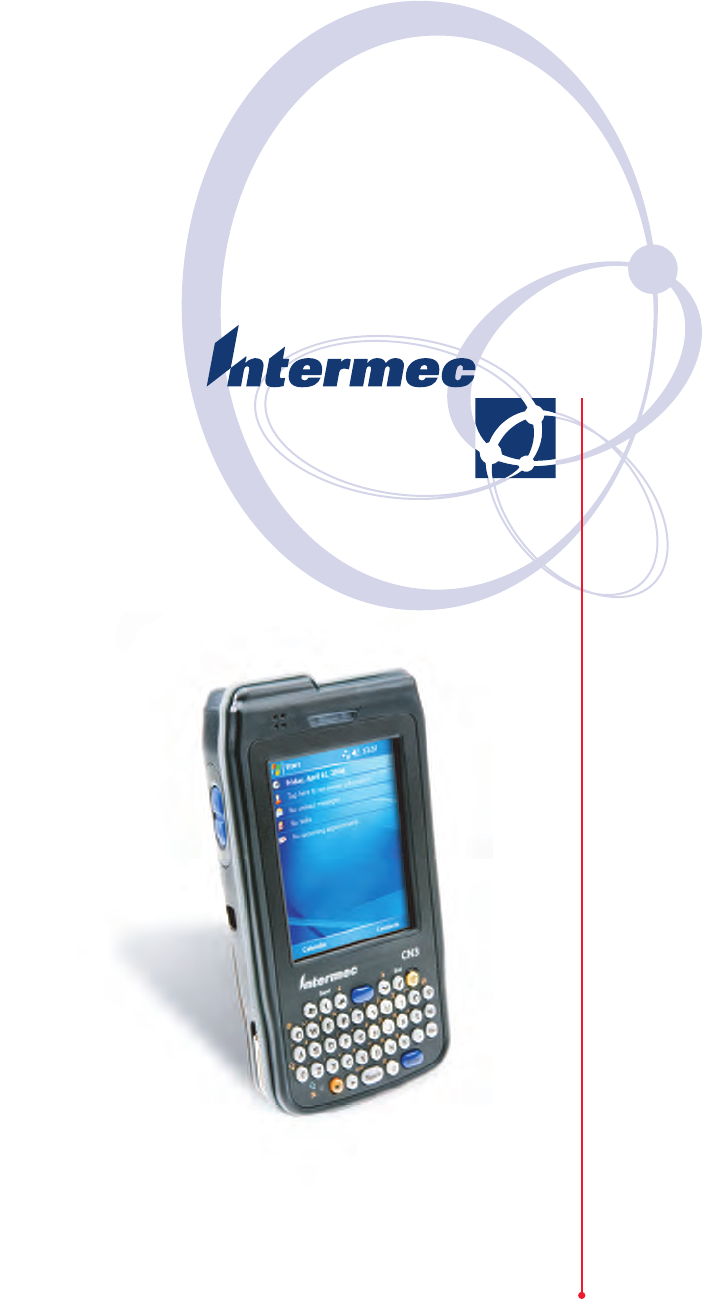
CN3 Mobile
Computer
User's Manual
ii PRELIMINARY - CN3 Mobile Computer User’s Manual
Intermec Technologies Corporation
Worldwide Headquarters Cedar Rapids Technical Communications
6001 36th Ave.W. 550 Second Street SE
Everett, WA 98203 Cedar Rapids, IA 52401
U.S.A. U.S.A.
www.intermec.com
The information contained herein is provided solely for the purpose of allowing customers to operate and ser-
vice Intermec-manufactured equipment and is not to be released, reproduced, or used for any other purpose
without written permission of Intermec Technologies Corporation.
Information and specifications contained in this document are subject to change without prior notice and do
not represent a commitment on the part of Intermec Technologies Corporation.
© 2006 by Intermec Technologies Corporation. All rights reserved.
The word Intermec, the Intermec logo, Norand, ArciTech, Beverage Routebook, CrossBar, dcBrowser, Durath-
erm, EasyADC, EasyCoder, EasySet, Fingerprint, i-gistics, INCA (under license), Intellitag, Intellitag Gen2,
JANUS, LabelShop, MobileLAN, Picolink, Ready-to-Work, RoutePower, Sabre, ScanPlus, ShopScan, Smart
Mobile Computing, TE 2000, Trakker Antares, and Vista Powered are either trademarks or registered trade-
marks of Intermec Technologies Corporation.
There are U.S. and foreign patents as well as U.S. and foreign patent applications pending.
Microsoft, Windows, and the Windows logo are registered trademarks of Microsoft Corporation in the United
States and/or other countries.
Bluetooth is a trademark of Bluetooth SIG, Inc., U.S.A.
Contents
CN3 Mobile Computer User’s Manual - PRELIMINARY iii
Contents
Before You Begin . . . . . . . . . . . . . . . . . . . . . . . . . . . . . . . . . . . . . . . . . . . . . . . . . . . . . . . . .ix
Safety Information . . . . . . . . . . . . . . . . . . . . . . . . . . . . . . . . . . . . . . . . . . . . . . . . . ix
Global Services and Support. . . . . . . . . . . . . . . . . . . . . . . . . . . . . . . . . . . . . . . . . . ix
Who Should Read this Manual. . . . . . . . . . . . . . . . . . . . . . . . . . . . . . . . . . . . . . . . x
Related Documents . . . . . . . . . . . . . . . . . . . . . . . . . . . . . . . . . . . . . . . . . . . . . . . . x
Patent Information . . . . . . . . . . . . . . . . . . . . . . . . . . . . . . . . . . . . . . . . . . . . . . . . . xi
1 Using the Computer. . . . . . . . . . . . . . . . . . . . . . . . . . . . . . . . . . . . . . . . . . . . . . . . . . . . . . . . . 1
Introducing the CN3 Mobile Computer . . . . . . . . . . . . . . . . . . . . . . . . . . . . . . . . . . . . . . . 2
Learning Software Build Versions . . . . . . . . . . . . . . . . . . . . . . . . . . . . . . . . . . . . . . . . . . . . 3
Resetting Your CN3 Computer . . . . . . . . . . . . . . . . . . . . . . . . . . . . . . . . . . . . . . . . . . . . . . 3
Scanning Bar Codes. . . . . . . . . . . . . . . . . . . . . . . . . . . . . . . . . . . . . . . . . . . . . . . . . . . . . . . 4
Scanning with the 2D Area Imager. . . . . . . . . . . . . . . . . . . . . . . . . . . . . . . . . . . . . 4
Reading Distances . . . . . . . . . . . . . . . . . . . . . . . . . . . . . . . . . . . . . . . . . . . . . . . . . 6
Using the Batteries. . . . . . . . . . . . . . . . . . . . . . . . . . . . . . . . . . . . . . . . . . . . . . . . . . . . . . . . 7
Charging and Installing the Battery . . . . . . . . . . . . . . . . . . . . . . . . . . . . . . . . . . . . 7
Maximizing Battery Life . . . . . . . . . . . . . . . . . . . . . . . . . . . . . . . . . . . . . . . . . . . . . 8
Checking the Battery Status . . . . . . . . . . . . . . . . . . . . . . . . . . . . . . . . . . . . . . . . . . 8
Adjusting the Beeper . . . . . . . . . . . . . . . . . . . . . . . . . . . . . . . . . . . . . . . . . . . . . . . . . . . . . . 9
Enabling the Beeper . . . . . . . . . . . . . . . . . . . . . . . . . . . . . . . . . . . . . . . . . . . . . . . . 9
Disabling the Beeper. . . . . . . . . . . . . . . . . . . . . . . . . . . . . . . . . . . . . . . . . . . . . . . 10
Intermec Settings Applet . . . . . . . . . . . . . . . . . . . . . . . . . . . . . . . . . . . . . . . . . . . . . . . . . . 10
Using the Keypad . . . . . . . . . . . . . . . . . . . . . . . . . . . . . . . . . . . . . . . . . . . . . . . . . . . . . . . 11
Using the Color-Coded Keys . . . . . . . . . . . . . . . . . . . . . . . . . . . . . . . . . . . . . . . . 12
Capitalizing All Characters . . . . . . . . . . . . . . . . . . . . . . . . . . . . . . . . . . . . . . . . . . 12
Using the Power (I/O) Switch . . . . . . . . . . . . . . . . . . . . . . . . . . . . . . . . . . . . . . . 12
Using the Screen . . . . . . . . . . . . . . . . . . . . . . . . . . . . . . . . . . . . . . . . . . . . . . . . . . . . . . . . 12
Software Tools. . . . . . . . . . . . . . . . . . . . . . . . . . . . . . . . . . . . . . . . . . . . . . . . . . . . . . . . . . 13
SmartSystems Foundation Console (www.intermec.com/SmartSystems) . . . . . . . 13
Intermec Resource Kits (www.intermec.com/IDL) . . . . . . . . . . . . . . . . . . . . . . . . 13
Using the Speakers. . . . . . . . . . . . . . . . . . . . . . . . . . . . . . . . . . . . . . . . . . . . . . . . . . . . . . . 14
Using the Status LEDs. . . . . . . . . . . . . . . . . . . . . . . . . . . . . . . . . . . . . . . . . . . . . . . . . . . . 15
Using the Storage Card . . . . . . . . . . . . . . . . . . . . . . . . . . . . . . . . . . . . . . . . . . . . . . . . . . . 16
Setting the Vibrator . . . . . . . . . . . . . . . . . . . . . . . . . . . . . . . . . . . . . . . . . . . . . . . . . . . . . . 17
Wireless Network Support. . . . . . . . . . . . . . . . . . . . . . . . . . . . . . . . . . . . . . . . . . . . . . . . . 18
Contents
iv PRELIMINARY - CN3 Mobile Computer User’s Manual
Accessories for the CN3 Computer . . . . . . . . . . . . . . . . . . . . . . . . . . . . . . . . . . . . . . . . . . 18
Physical and Environmental Specifications . . . . . . . . . . . . . . . . . . . . . . . . . . . . . . . . . . . . 19
2 Windows Mobile. . . . . . . . . . . . . . . . . . . . . . . . . . . . . . . . . . . . . . . . . . . . . . . . . . . . . . . . . . . . 21
Software Builds . . . . . . . . . . . . . . . . . . . . . . . . . . . . . . . . . . . . . . . . . . . . . . . . . . . . . . . . . 22
Where to Find Information . . . . . . . . . . . . . . . . . . . . . . . . . . . . . . . . . . . . . . . . . . . . . . . . 22
Basic Usage . . . . . . . . . . . . . . . . . . . . . . . . . . . . . . . . . . . . . . . . . . . . . . . . . . . . . . . . . . . . 22
Today Screen . . . . . . . . . . . . . . . . . . . . . . . . . . . . . . . . . . . . . . . . . . . . . . . . . . . . 23
Programs . . . . . . . . . . . . . . . . . . . . . . . . . . . . . . . . . . . . . . . . . . . . . . . . . . . . . . . 23
Navigation Bar and Command Bar. . . . . . . . . . . . . . . . . . . . . . . . . . . . . . . . . . . . 24
Pop-up Menus . . . . . . . . . . . . . . . . . . . . . . . . . . . . . . . . . . . . . . . . . . . . . . . . . . . 24
Notifications. . . . . . . . . . . . . . . . . . . . . . . . . . . . . . . . . . . . . . . . . . . . . . . . . . . . . 25
Entering Information . . . . . . . . . . . . . . . . . . . . . . . . . . . . . . . . . . . . . . . . . . . . . . 25
Typing With the Onscreen Keyboard . . . . . . . . . . . . . . . . . . . . . . . . . . . 26
Using Block Recognizer. . . . . . . . . . . . . . . . . . . . . . . . . . . . . . . . . . . . . . 27
Using Letter Recognizer . . . . . . . . . . . . . . . . . . . . . . . . . . . . . . . . . . . . . 27
Using Transcriber . . . . . . . . . . . . . . . . . . . . . . . . . . . . . . . . . . . . . . . . . . 27
Selecting Typed Text. . . . . . . . . . . . . . . . . . . . . . . . . . . . . . . . . . . . . . . . 28
Writing on the Screen. . . . . . . . . . . . . . . . . . . . . . . . . . . . . . . . . . . . . . . . . . . . . . 28
Selecting the Writing. . . . . . . . . . . . . . . . . . . . . . . . . . . . . . . . . . . . . . . . 28
Converting Writing to Text. . . . . . . . . . . . . . . . . . . . . . . . . . . . . . . . . . . 29
Drawing on the Screen . . . . . . . . . . . . . . . . . . . . . . . . . . . . . . . . . . . . . . . . . . . . . 30
Creating a Drawing . . . . . . . . . . . . . . . . . . . . . . . . . . . . . . . . . . . . . . . . . 30
Selecting a Drawing. . . . . . . . . . . . . . . . . . . . . . . . . . . . . . . . . . . . . . . . . 30
Recording a Message. . . . . . . . . . . . . . . . . . . . . . . . . . . . . . . . . . . . . . . . . . . . . . . 31
Using My Text . . . . . . . . . . . . . . . . . . . . . . . . . . . . . . . . . . . . . . . . . . . . . . . . . . . 31
Finding and Organizing Information . . . . . . . . . . . . . . . . . . . . . . . . . . . . . . . . . . 32
Customizing Your CN3 Computer . . . . . . . . . . . . . . . . . . . . . . . . . . . . . . . . . . . 33
Adjusting Settings . . . . . . . . . . . . . . . . . . . . . . . . . . . . . . . . . . . . . . . . . . 33
Adding or Removing Programs . . . . . . . . . . . . . . . . . . . . . . . . . . . . . . . . 33
Microsoft ActiveSync. . . . . . . . . . . . . . . . . . . . . . . . . . . . . . . . . . . . . . . . . . . . . . . . . . . . . 36
Microsoft Pocket Outlook . . . . . . . . . . . . . . . . . . . . . . . . . . . . . . . . . . . . . . . . . . . . . . . . . 38
Calendar: Scheduling Appointments and Meetings. . . . . . . . . . . . . . . . . . . . . . . . 38
Synchronizing Calendar. . . . . . . . . . . . . . . . . . . . . . . . . . . . . . . . . . . . . . 39
Why Use Categories in the Calendar? . . . . . . . . . . . . . . . . . . . . . . . . . . . 39
What’s an All Day Event? . . . . . . . . . . . . . . . . . . . . . . . . . . . . . . . . . . . . 40
What’s a Recurrence Pattern? . . . . . . . . . . . . . . . . . . . . . . . . . . . . . . . . . 41
Viewing Appointments . . . . . . . . . . . . . . . . . . . . . . . . . . . . . . . . . . . . . . 41
Creating or Changing an Appointment . . . . . . . . . . . . . . . . . . . . . . . . . . 42
Creating an All-Day Event . . . . . . . . . . . . . . . . . . . . . . . . . . . . . . . . . . . 42
Setting a Reminder for an Appointment . . . . . . . . . . . . . . . . . . . . . . . . . 43
Adding a Note to an Appointment . . . . . . . . . . . . . . . . . . . . . . . . . . . . . 44
Making an Appointment Recurring. . . . . . . . . . . . . . . . . . . . . . . . . . . . . 45
Assigning an Appointment to a Category. . . . . . . . . . . . . . . . . . . . . . . . . 45
Sending a Meeting Request . . . . . . . . . . . . . . . . . . . . . . . . . . . . . . . . . . . 46
Finding an Appointment. . . . . . . . . . . . . . . . . . . . . . . . . . . . . . . . . . . . . 47
Deleting an Appointment . . . . . . . . . . . . . . . . . . . . . . . . . . . . . . . . . . . . 47
Contents
CN3 Mobile Computer User’s Manual - PRELIMINARY v
Changing Calendar Options . . . . . . . . . . . . . . . . . . . . . . . . . . . . . . . . . . 47
Contacts: Tracking Friends and Colleagues . . . . . . . . . . . . . . . . . . . . . . . . . . . . . 48
Creating a Contact . . . . . . . . . . . . . . . . . . . . . . . . . . . . . . . . . . . . . . . . . 48
Synchronizing Contacts. . . . . . . . . . . . . . . . . . . . . . . . . . . . . . . . . . . . . . 49
Viewing Contacts . . . . . . . . . . . . . . . . . . . . . . . . . . . . . . . . . . . . . . . . . . 49
Creating or Changing a Contact . . . . . . . . . . . . . . . . . . . . . . . . . . . . . . . 50
Adding a Note to a Contact. . . . . . . . . . . . . . . . . . . . . . . . . . . . . . . . . . . 50
Assigning a Contact to a Category . . . . . . . . . . . . . . . . . . . . . . . . . . . . . . 51
Copying a Contact . . . . . . . . . . . . . . . . . . . . . . . . . . . . . . . . . . . . . . . . . 51
Sending a Message to a Contact. . . . . . . . . . . . . . . . . . . . . . . . . . . . . . . . 51
Finding a Contact . . . . . . . . . . . . . . . . . . . . . . . . . . . . . . . . . . . . . . . . . . 52
Deleting a Contact . . . . . . . . . . . . . . . . . . . . . . . . . . . . . . . . . . . . . . . . . 52
Changing Contacts Options . . . . . . . . . . . . . . . . . . . . . . . . . . . . . . . . . . 53
Tasks: Keeping a To Do List . . . . . . . . . . . . . . . . . . . . . . . . . . . . . . . . . . . . . . . . 53
Creating a Task . . . . . . . . . . . . . . . . . . . . . . . . . . . . . . . . . . . . . . . . . . . . 53
Synchronizing Tasks . . . . . . . . . . . . . . . . . . . . . . . . . . . . . . . . . . . . . . . . 54
Notes: Capturing Thoughts and Ideas . . . . . . . . . . . . . . . . . . . . . . . . . . . . . . . . . 54
Creating a Note. . . . . . . . . . . . . . . . . . . . . . . . . . . . . . . . . . . . . . . . . . . . 55
Synchronizing Notes . . . . . . . . . . . . . . . . . . . . . . . . . . . . . . . . . . . . . . . . 55
Messaging: Sending and Receiving E-mail Messages . . . . . . . . . . . . . . . . . . . . . . . 56
Synchronizing E-mail Messages . . . . . . . . . . . . . . . . . . . . . . . . . . . . . . . . 56
Managing E-mail Messages and Folders. . . . . . . . . . . . . . . . . . . . . . . . . . 57
Connecting to a Mail Server . . . . . . . . . . . . . . . . . . . . . . . . . . . . . . . . . . 58
Composing and Sending Messages . . . . . . . . . . . . . . . . . . . . . . . . . . . . . 59
Companion Programs . . . . . . . . . . . . . . . . . . . . . . . . . . . . . . . . . . . . . . . . . . . . . . . . . . . . 60
Word Mobile . . . . . . . . . . . . . . . . . . . . . . . . . . . . . . . . . . . . . . . . . . . . . . . . . . . . 60
Creating a Document . . . . . . . . . . . . . . . . . . . . . . . . . . . . . . . . . . . . . . . 60
Typing Mode . . . . . . . . . . . . . . . . . . . . . . . . . . . . . . . . . . . . . . . . . . . . . 61
Writing Mode . . . . . . . . . . . . . . . . . . . . . . . . . . . . . . . . . . . . . . . . . . . . . 62
Synchronizing Word Mobile Documents . . . . . . . . . . . . . . . . . . . . . . . . 62
Excel Mobile. . . . . . . . . . . . . . . . . . . . . . . . . . . . . . . . . . . . . . . . . . . . . . . . . . . . . 62
Creating a Workbook . . . . . . . . . . . . . . . . . . . . . . . . . . . . . . . . . . . . . . . 63
Tips for Working in Excel Mobile. . . . . . . . . . . . . . . . . . . . . . . . . . . . . . 63
PowerPoint Mobile. . . . . . . . . . . . . . . . . . . . . . . . . . . . . . . . . . . . . . . . . . . . . . . . 64
Windows Media Player for Windows Mobile . . . . . . . . . . . . . . . . . . . . . . . . . . . 65
Internet Explorer Mobile . . . . . . . . . . . . . . . . . . . . . . . . . . . . . . . . . . . . . . . . . . . . . . . . . . 66
Mobile Favorites. . . . . . . . . . . . . . . . . . . . . . . . . . . . . . . . . . . . . . . . . . . . . . . . . . 66
Favorite Links. . . . . . . . . . . . . . . . . . . . . . . . . . . . . . . . . . . . . . . . . . . . . . . . . . . . 66
Mobile Favorites. . . . . . . . . . . . . . . . . . . . . . . . . . . . . . . . . . . . . . . . . . . . . . . . . . 66
Using Internet Explorer Mobile . . . . . . . . . . . . . . . . . . . . . . . . . . . . . . . . . . . . . . 68
Viewing Mobile Favorites and Channels . . . . . . . . . . . . . . . . . . . . . . . . . 68
Browsing the Internet . . . . . . . . . . . . . . . . . . . . . . . . . . . . . . . . . . . . . . . 68
3 Configuring the Computer. . . . . . . . . . . . . . . . . . . . . . . . . . . . . . . . . . . . . . . . . . . . . . . . . 69
Developing Applications for the Computer . . . . . . . . . . . . . . . . . . . . . . . . . . . . . . . . . . . . 70
Packaging Applications for the CN3 Computer. . . . . . . . . . . . . . . . . . . . . . . . . . . . . . . . . 70
Contents
vi PRELIMINARY - CN3 Mobile Computer User’s Manual
Installing Applications on the Computer . . . . . . . . . . . . . . . . . . . . . . . . . . . . . . . . . . . . . . 71
Using Microsoft ActiveSync . . . . . . . . . . . . . . . . . . . . . . . . . . . . . . . . . . . . . . . . . 71
Using a Storage Card . . . . . . . . . . . . . . . . . . . . . . . . . . . . . . . . . . . . . . . . . . . . . . 72
Using Wavelink Avalanche . . . . . . . . . . . . . . . . . . . . . . . . . . . . . . . . . . . . . . . . . . 72
Using the SmartSystems Console . . . . . . . . . . . . . . . . . . . . . . . . . . . . . . . . . . . . . 73
Updating the System Software. . . . . . . . . . . . . . . . . . . . . . . . . . . . . . . . . . . . . . . . . . . . . . 73
Using a Storage Card to Upgrade the Computer . . . . . . . . . . . . . . . . . . . . . . . . . 74
Upgrading Both Operating System and SSPB Files . . . . . . . . . . . . . . . . . 74
Upgrading the Operating System . . . . . . . . . . . . . . . . . . . . . . . . . . . . . . 75
Upgrading the SSPB Files . . . . . . . . . . . . . . . . . . . . . . . . . . . . . . . . . . . . 75
Using the SmartSystems Console to Upgrade the CN3 Computer . . . . . . . . . . . . 76
Launching Your Application Automatically . . . . . . . . . . . . . . . . . . . . . . . . . . . . . . . . . . . . 76
RunAutoRun . . . . . . . . . . . . . . . . . . . . . . . . . . . . . . . . . . . . . . . . . . . . . . . . . . . . 77
AutoExec . . . . . . . . . . . . . . . . . . . . . . . . . . . . . . . . . . . . . . . . . . . . . . . . . . . . . . . 78
AutoRun. . . . . . . . . . . . . . . . . . . . . . . . . . . . . . . . . . . . . . . . . . . . . . . . . . . . . . . . 79
AutoCopy. . . . . . . . . . . . . . . . . . . . . . . . . . . . . . . . . . . . . . . . . . . . . . . . . . . . . . . 80
AutoReg . . . . . . . . . . . . . . . . . . . . . . . . . . . . . . . . . . . . . . . . . . . . . . . . . . . . . . . . 81
AutoCab. . . . . . . . . . . . . . . . . . . . . . . . . . . . . . . . . . . . . . . . . . . . . . . . . . . . . . . . 81
Customizing How Applications Load on the Computer . . . . . . . . . . . . . . . . . . . . . . . . . . 82
Configuring CN3 Parameters . . . . . . . . . . . . . . . . . . . . . . . . . . . . . . . . . . . . . . . . . . . . . . 83
Configuring the CN3 Computer With Intermec Settings. . . . . . . . . . . . . . . . . . . 84
Synchronizing the CN3 Computer System Time with a Time Server. . . . . . . . . . 84
Configuring the CN3 Computer through the Network . . . . . . . . . . . . . . . . . . . . 84
Configuring the CN3 Computer in a TCP/IP Direct Connect Network. 85
Configuring the CN3 Computer in a UDP Plus Network. . . . . . . . . . . . 86
Configuring the Color Camera . . . . . . . . . . . . . . . . . . . . . . . . . . . . . . . . . . . . . . . . . . . . . 87
Configuring the SF51 Scanner. . . . . . . . . . . . . . . . . . . . . . . . . . . . . . . . . . . . . . . . . . . . . . 88
Imager Settings. . . . . . . . . . . . . . . . . . . . . . . . . . . . . . . . . . . . . . . . . . . . . . . . . . . 88
Creating an SF51 Connection Label. . . . . . . . . . . . . . . . . . . . . . . . . . . . . . . . . . . 88
Viewing SF51 Scanner Information from Your CN3 Computer. . . . . . . . . . . . . . 90
Using Configuration Parameters . . . . . . . . . . . . . . . . . . . . . . . . . . . . . . . . . . . . . . . . . . . . 90
4 Maintaining the Computer . . . . . . . . . . . . . . . . . . . . . . . . . . . . . . . . . . . . . . . . . . . . . . . . 91
Upgrading the Operating System on your CN3 Computer . . . . . . . . . . . . . . . . . . . . . . . . 92
Troubleshooting Your CN3 Computer . . . . . . . . . . . . . . . . . . . . . . . . . . . . . . . . . . . . . . . 92
Cleaning the Scanner and Camera Windows and Screen . . . . . . . . . . . . . . . . . . . . . . . . . . 97
Contents
CN3 Mobile Computer User’s Manual - PRELIMINARY vii
5 Network Support . . . . . . . . . . . . . . . . . . . . . . . . . . . . . . . . . . . . . . . . . . . . . . . . . . . . . . . . . . . 99
Personal Area Networks. . . . . . . . . . . . . . . . . . . . . . . . . . . . . . . . . . . . . . . . . . . . . . . . . . 100
Wireless Manager . . . . . . . . . . . . . . . . . . . . . . . . . . . . . . . . . . . . . . . . . . . . . . . . 100
Bluetooth . . . . . . . . . . . . . . . . . . . . . . . . . . . . . . . . . . . . . . . . . . . . . . . . . . . . . . 101
Mode. . . . . . . . . . . . . . . . . . . . . . . . . . . . . . . . . . . . . . . . . . . . . . . . . . . 101
Devices . . . . . . . . . . . . . . . . . . . . . . . . . . . . . . . . . . . . . . . . . . . . . . . . . 101
COM Ports . . . . . . . . . . . . . . . . . . . . . . . . . . . . . . . . . . . . . . . . . . . . . . 103
Wireless Printing . . . . . . . . . . . . . . . . . . . . . . . . . . . . . . . . . . . . . . . . . . . . . . . . 105
Bluetooth Audio. . . . . . . . . . . . . . . . . . . . . . . . . . . . . . . . . . . . . . . . . . . . . . . . . 107
Discovering Bluetooth Headsets . . . . . . . . . . . . . . . . . . . . . . . . . . . . . . 108
Connecting to a Bluetooth Headset. . . . . . . . . . . . . . . . . . . . . . . . . . . . 108
Configuring Bluetooth Using Intermec Settings . . . . . . . . . . . . . . . . . . . . . . . . . 109
Connecting with Bluetooth . . . . . . . . . . . . . . . . . . . . . . . . . . . . . . . . . . . . . . . . 110
Local Area Networks . . . . . . . . . . . . . . . . . . . . . . . . . . . . . . . . . . . . . . . . . . . . . . . . . . . . 113
Configuring 802.11b/g Radio Communications. . . . . . . . . . . . . . . . . . . . . . . . . 113
Configuring the Network Parameters for a TCP/IP Network . . . . . . . . 113
Configuring the Network Parameters for a UDP Plus Network. . . . . . . 113
Phone Application (GPRS/GSM Radios) . . . . . . . . . . . . . . . . . . . . . . . . . . . . . . . . . . . . 114
Activation. . . . . . . . . . . . . . . . . . . . . . . . . . . . . . . . . . . . . . . . . . . . . . . . . . . . . . 114
Wireless Manager . . . . . . . . . . . . . . . . . . . . . . . . . . . . . . . . . . . . . . . . . 114
Phone Application. . . . . . . . . . . . . . . . . . . . . . . . . . . . . . . . . . . . . . . . . 115
Call History. . . . . . . . . . . . . . . . . . . . . . . . . . . . . . . . . . . . . . . . . . . . . . 115
Speed Dial. . . . . . . . . . . . . . . . . . . . . . . . . . . . . . . . . . . . . . . . . . . . . . . 115
Tools . . . . . . . . . . . . . . . . . . . . . . . . . . . . . . . . . . . . . . . . . . . . . . . . . . . 116
Phone Settings. . . . . . . . . . . . . . . . . . . . . . . . . . . . . . . . . . . . . . . . . . . . 116
Remote Access (Modems) . . . . . . . . . . . . . . . . . . . . . . . . . . . . . . . . . . . . . . . . . . . . . . . . 118
Connecting to an Internet Service Provider . . . . . . . . . . . . . . . . . . . . . . . . . . . . 119
Connecting to Work. . . . . . . . . . . . . . . . . . . . . . . . . . . . . . . . . . . . . . . . . . . . . . 121
Creating a VPN Server Connection to Work . . . . . . . . . . . . . . . . . . . . . . . . . . . 124
Ending a Connection . . . . . . . . . . . . . . . . . . . . . . . . . . . . . . . . . . . . . . . . . . . . . 125
iConnect . . . . . . . . . . . . . . . . . . . . . . . . . . . . . . . . . . . . . . . . . . . . . . . . . . . . . . . . . . . . . 126
No Networking . . . . . . . . . . . . . . . . . . . . . . . . . . . . . . . . . . . . . . . . . . . . . . . . . 126
Wireless Communications . . . . . . . . . . . . . . . . . . . . . . . . . . . . . . . . . . . . . . . . . 126
Ping Test . . . . . . . . . . . . . . . . . . . . . . . . . . . . . . . . . . . . . . . . . . . . . . . . . . . . . . 127
Configuring Security . . . . . . . . . . . . . . . . . . . . . . . . . . . . . . . . . . . . . . . . . . . . . . . . . . . . 128
Loading Certificates . . . . . . . . . . . . . . . . . . . . . . . . . . . . . . . . . . . . . . . . . . . . . . 128
Wireless Network . . . . . . . . . . . . . . . . . . . . . . . . . . . . . . . . . . . . . . . . . . . . . . . . 128
Choosing Between Microsoft and Funk Security . . . . . . . . . . . . . . . . . . . . . . . . 130
Configuring Funk Security . . . . . . . . . . . . . . . . . . . . . . . . . . . . . . . . . . 131
Configuring Microsoft Security . . . . . . . . . . . . . . . . . . . . . . . . . . . . . . . 148
Management . . . . . . . . . . . . . . . . . . . . . . . . . . . . . . . . . . . . . . . . . . . . . . . . . . . . . . . . . . 153
SmartSystems™ Foundation Console (www.intermec.com/SmartSystems) . . . . . 153
SNMP Configuration on the Mobile Computer. . . . . . . . . . . . . . . . . . . . . . . . . 154
Object Identifiers. . . . . . . . . . . . . . . . . . . . . . . . . . . . . . . . . . . . . . . . . . 155
Configuring with SNMP. . . . . . . . . . . . . . . . . . . . . . . . . . . . . . . . . . . . 156
Contents
viii PRELIMINARY - CN3 Mobile Computer User’s Manual
I Index . . . . . . . . . . . . . . . . . . . . . . . . . . . . . . . . . . . . . . . . . . . . . . . . . . . . . . . . . . . . . . . . . . . . . . . . 157

Before You Begin
CN3 Mobile Computer User’s Manual - PRELIMINARY ix
Before You Begin
This section provides you with safety information, technical support infor-
mation, and sources for additional product information.
Safety Information
Your safety is extremely important. Read and follow all warnings and cau-
tions in this document before handling and operating Intermec equipment.
You can be seriously injured, and equipment and data can be damaged if
you do not follow the safety warnings and cautions.
This section explains how to identify and understand dangers, warnings,
cautions, and notes that are in this manual..
Global Services and Support
Warranty Information
To understand the warranty for your Intermec product, visit the Intermec
web site at www.intermec.com and click Service & Support. The Intermec
Global Sales & Service page appears. From the Service & Support menu,
move your pointer over Support, and then click Warranty.
Disclaimer of warranties: The sample code included in this document is
presented for reference only. The code does not necessarily represent com-
plete, tested programs. The code is provided “as is with all faults.” All war-
ranties are expressly disclaimed, including the implied warranties of
merchantability and fitness for a particular purpose.
Web Support
Visit the Intermec web site at www.intermec.com to download our current
manuals (in PDF). To order printed versions of the Intermec manuals, con-
tact your local Intermec representative or distributor.
Visit the Intermec technical knowledge base (Knowledge Central) at
intermec.custhelp.com to review technical information or to request
technical support for your Intermec product.
A warning alerts you of an operating procedure, practice, condition, or
statement that must be strictly observed to avoid death or serious injury
to the persons working on the equipment.
A caution alerts you to an operating procedure, practice, condition, or
statement that must be strictly observed to prevent equipment damage
or destruction, or corruption or loss of data.
Note: Notes either provide extra information about a topic or contain spe-
cial instructions for handling a particular condition or set of circumstances.

Before You Begin
x PRELIMINARY - CN3 Mobile Computer User’s Manual
Telephone Support
These services are available from Intermec Technologies Corporation.
Outside the U.S.A. and Canada, contact your local Intermec representative.
Click Contact from the Intermec web site to search for your representative.
Who Should Read this Manual
This manual is written for the person who is responsible for installing, con-
figuring, and maintaining the CN3 Computer.
This document provides you with information about the features of the
CN3 Computer, and how to install, configure, operate, maintain, and
troubleshoot it.
Before you work with the CN3 Computer, you should be familiar with
your network and general networking terms, such as IP address.
Related Documents
This table contains a list of related Intermec documents and their part
numbers.
The Intermec web site at www.intermec.com contains our documents (as
PDF files) that you can download for free.
Service Description
In the U.S.A. and
Canada, call 1-800-755-
5505 and choose this
option
Order Intermec
products
•Place an order.
• Ask about an existing order.
1 and then choose 2
Order Intermec
media
Order printer labels and
ribbons.
1 and then choose 1
Order spare parts Order spare parts 1 or 2 and then choose 4
Tec h nic a l Supp ort Talk to technical support about
your Intermec product.
2 and then choose 2
Service • Get a return authorization
number for authorized ser-
vice center repair.
• Request an on-site repair
technician.
2 and then choose 1
Service contracts • Ask about an existing con-
tract.
• Renew a contract.
• Inquire about repair billing
or other service invoicing
questions.
1 or 2 and then choose 3

Before You Begin
CN3 Mobile Computer User’s Manual - PRELIMINARY xi
To download documents
1Visit the Intermec web site at www.intermec.com.
2Click Service & Support > Manuals.
3In the Select a Product field, choose the product whose documentation
you want to download.
To order printed versions of the Intermec manuals, contact your local
Intermec representative or distributor.
Patent Information
This product is protected by one or more of the following patents: 4882476;
4894523; 4953113; 4961043; 4970379; 4988852; 5019699; 5021642; 5038024;
5081343; 5095197; 5144119; 5144121; 5182441; 5187355; 5187356; 5195183;
5216233; 5216550; 5195183; 5195183; 5218191; 5227614; 5233172; 5241488;
5243602; 5258606; 5278487; 5288985; 5308966; 5322991; 5331136; 5331580;
5342210; 5349678; 5359185; 5371858; 5373478; 5389770; 5397885; 5410141;
5414251; 5416463; 5442167; 5464972; 5468947; 5468950; 5477044; 5486689;
5488575; 5500516; 5502297; 5504367; 5508599; 5514858; 5530619; 5534684;
5536924; 5539191; 5541419; 5548108; 5550362; 5550364; 5565669; 5567925;
5568645; 5572007; 5576529; 5592512; 5594230; 5598007; 5608578; 5616909;
5619027; 5627360; 5640001; 5657317; 5659431; 5671436; 5672860; 5684290;
5719678; 5729003; 5742041; 5761219; 5764798; 5777308; 5777309; 5777310;
5786583; 5793604; 5798509; 5798513; 5804805; 5805807; 5811776; 5811777;
5818027; 5821523; 5828052; 5831819; 5834753; 5834749; 5837987; 5841121;
5842070; 5844222; 5854478; 5862267; 5869840; 5873070; 5877486; 5878395;
5883492; 5883493; 5886338; 5889386; 5892971; 5895906; 5898162; 5902987;
5902988; 5912452; 5923022; 5936224; 5949056; 5969321; 5969326; 5969328;
5979768; 5986435; 5987192; 5987499; 5992750; 6003775; 6012640; 6016960;
6018597; 6024289; 6034379; 6036093; 6039252; 6064763; 6075340; 6095422;
6097839; 6102289; 6102295; 6109528; 6119941; 6128414; 6138915; 6149061;
6149063; 6152370; 6155490; 6158661; 6164542; 6164545; 6173893; 6195053;
6234393; 6234395; 6244512; 6249008; 6328214; 6330975; 6345765; 6356949;
6367699; 6375075; 6375076; 6375344; 6431451; 6435411; 6484944; 6488209;
6497368; 6532152; 6538413; 6539422; 6621942; 6641046; 6681994; 6687403;
6688523; 6732930
Docking Station/Device
5052943; 5195183; 5317691; 5331580; 5544010; 5644471
There may other U.S. and foreign patents pending.
Document Title Part Number
CN3 Mobile Computer Quick Start Guide 962-054-115
Intermec Computer Command Reference Manual 073529
TE 2000 Terminal Emulation Programmer’s Guide 977-055-008
Before You Begin
xii PRELIMINARY - CN3 Mobile Computer User’s Manual

CN3 Mobile Computer User’s Manual - PRELIMINARY 1
1Using the Computer
This chapter introduces the CN3 Mobile Computer, developed by Inter-
mec to enhance wireless connectivity needs and contains hardware and soft-
ware configuration information to assist you in making the most out of
your CN3 Computer.
Note: Desktop icons and applet icons are shown to the left. Any place that
Start is mentioned, tap the following Windows icon in the top, left corner
of your CN3 desktop.
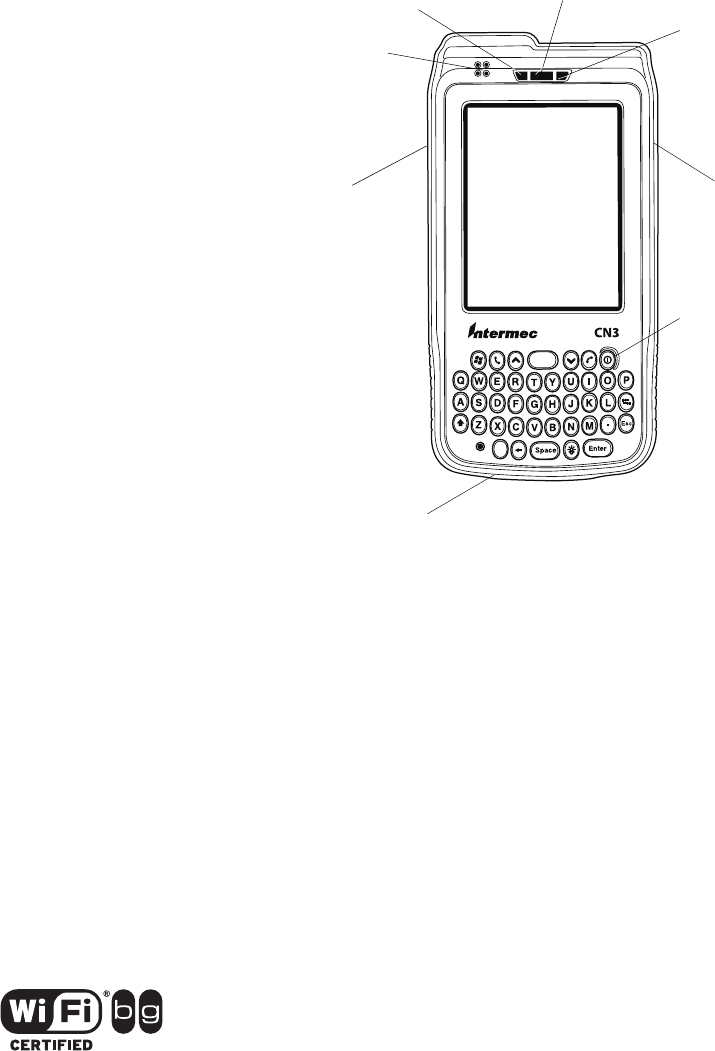
Chapter 1 — Using the Computer
2 PRELIMINARY - CN3 Mobile Computer User’s Manual
Introducing the CN3 Mobile Computer
The Intermec CN3 Mobile Computer is a small, ergonomically designed
mobile computer built on the Microsoftr Windowsr Mobile 5.0 operating
system. It is a lightweight, easy-to-use, reliable computer that runs client/
server applications, terminal emulation applications, as well as browser-
based applications.
The CN3 Computer is available with the following:
• 802.11b/g radio option
• Bluetooth - *Bluetooth is a trademark owned by Bluetooth SIG, Inc., USA
• 128MB SDRAM - no loading option
• Disk on Chip (128MB)
• EA11, EA11HD, or color camera
• GPRS/GSM or CDMA radio options
• Single Dock options: attach to USB port on dock, USB-to-Ethernet
dongle, or USB-to-Modem dongle
• Vehicle Dock: USB adapter cable or USB-to-RS232 adapter cable
Use this manual to understand how to use the features and options avail-
able on the CN3 Computer.
CN3 Computers with an IEEE 802.11b/g radio installed are Wi-Fir certi-
fied for interoperability with other 802.11b/g wireless LAN devices.
Battery Status LED
Scan LED and Intermec Ready-to-Work Indicator
Microphone
Front Speaker
2 remappable buttons
Notification LED
2 remappable buttons
Power switch
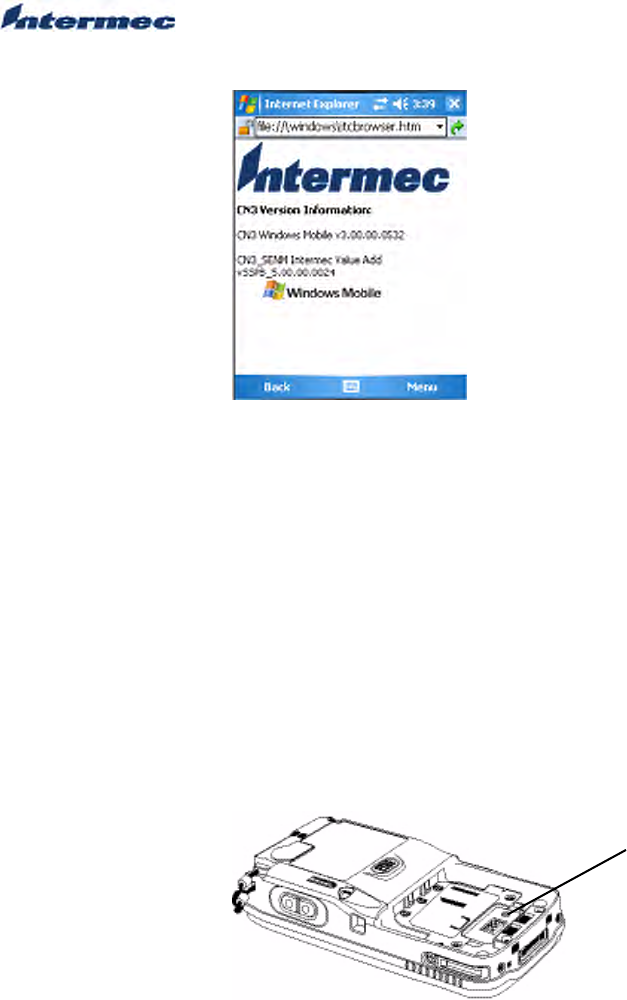
Chapter 1 — Using the Computer
CN3 Mobile Computer User’s Manual - PRELIMINARY 3
Learning Software Build Versions
The SmartSystems Platform Bundle (SSPB) is an area of storage embedded
in a section of the system’s FLASH memory. This storage area is not erased
when a clean-boot is performed. It may, however, be erased during the
reflashing process. In addition to storing applications and data files, you do
have the option to store a persistent registry to the SSPB region.
To check to see if your CN3 Computer has the latest SSPB or operating
system build, do the following:
2Note the information beneath the CN3 Version Information title.
3Tap the Close icon in the top right corner to exit the Internet Explorer.
Resetting Your CN3 Computer
In cases where the CN3 Computer completely stops responding, an appli-
cation is locked up and does not respond, when you upgrade the firmware,
or when you reflash the CN3 Computer, it may be necessary to perform a
clean-boot. Note that this will erase the memory in the CN3 Computer.
To perform a clean-boot
1Press the power switch to suspend the CN3 Computer, then remove the
battery pack from the back of the CN3 Computer.
2Simultaneously press the power switch in front and (with a stylus) the
cold reset switch in the battery cavity in the back.
1Select Start > Internet Explorer > the Intermec logo.
Cold reset switch
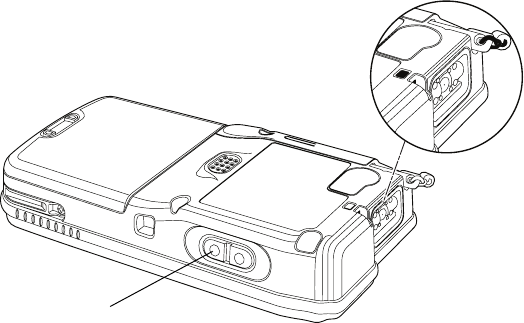
Chapter 1 — Using the Computer
4 PRELIMINARY - CN3 Mobile Computer User’s Manual
Scanning Bar Codes
Use the scanner to scan and enter bar code data. The type of scanner you
are using and the type of bar code you are decoding determines the way you
scan the bar code. The CN3 Computer supports scanning 2D images.
When you unpack the CN3 Computer, the following bar code symbologies
are enabled:
• Code 39
• Code 128
•UPC-A
•UPC-E
•EAN-8
• EAN-13
• Datamatrix
If you are using bar code labels that are encoded in a different symbology,
you need to enable the symbology on the computer. Use the Intermec Set-
tings applet to enable and disable symbologies for your scanner. See the
Intermec Computer Command Reference Manual available from the Intermec
web site at www.intermec.com.
Scanning with the 2D Area Imager
The CN3 Computer has the 2D area imager, which scans 2D bar code
symbologies and supports omni-directional (360°) scanning where you can
position the CN3 Computer in any orientation to scan a bar code label.
Using the 2D imager is like taking a picture with a digital camera.
1Press the power switch to turn on the CN3 Computer, point the scanner
window a few inches from the bar code label, and hold steady.
2Press the Scan button and center the red aiming beam over the bar code
label. The aiming beam is smaller when the imager is closer to the bar
code and larger when it is further away.
Scan button
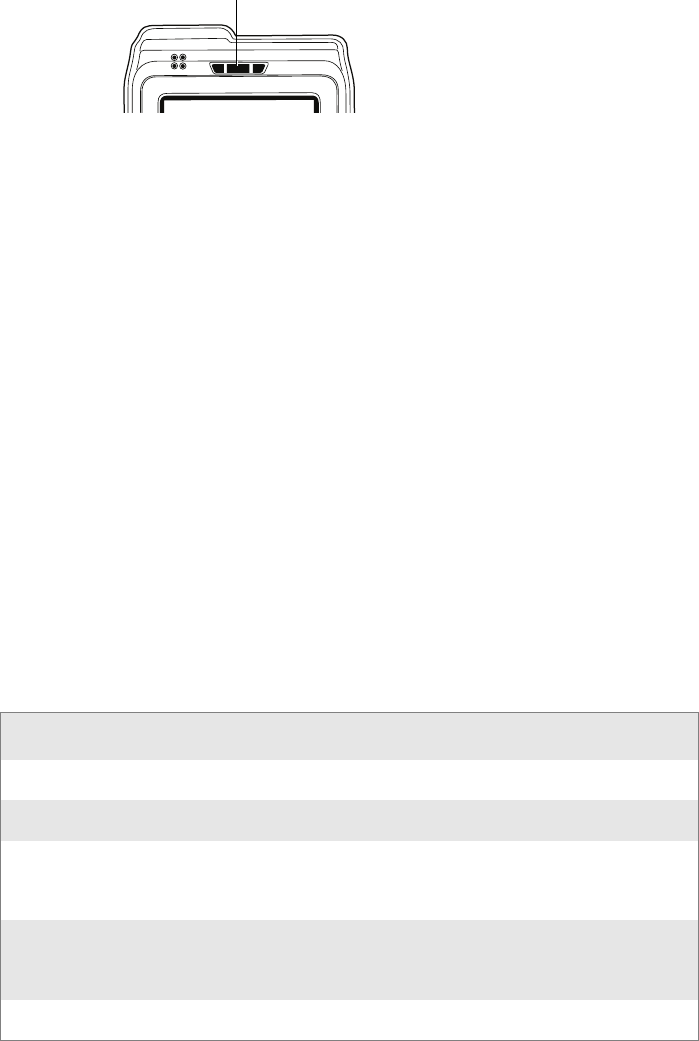
Chapter 1 — Using the Computer
CN3 Mobile Computer User’s Manual - PRELIMINARY 5
When the CN3 Computer successfully reads a bar code label, a high
beep is emitted and the Scan LED lights briefly.
3Release the Scan button.
If you have problems scanning a bar code with the 2D imager, try following
some of these tips to improve the performance of your imager:
• Change to another predefined imager mode:
• Select 1D if only 1D labels are needed.
• Select 1D and 2D Bright Environment if scanning in high ambient
light (such as outdoors in sunshine).
• Select 1D and 2D Reflective Surface if scanning glossy labels.
• Select 1D and 2D Standard for all other cases.
• Keep your hand as steady as possible while scanning a label.
• Position the imager as close to the bar code as possible while still being
able to capture the entire bar code.
• Enable only the bar codes that you need to use every day.
Below are the minimum reading distances for CN3 Computers using the
2D area imager. When correctly mounted, an exit window reduces reading
distances by about 4%.
Use Intermec Settings to configure these imager commands. For more
information on the commands and their parameters, see the Intermec Com-
puter Command Reference Manual (P/N: 073529) available from the Inter-
mec web site at www.intermec.com.
2D Area Imager Reading Distances with 0.04” Setbacks
Symbology Density Near Distance Far Distance
MaxiCode 35 mil 4.98 cm/ 1.96” 33.92 cm/ 12.96”
Datamatrix 15 mil 9.30 cm/ 3.66” 16.41 cm/ 6.46”
PDF417 10 mil
8 mil
6.6 mil
7.77 cm/ 3.06”
8.28 cm/ 3.26”
11.33 cm/ 4.46”
22.76 cm/ 8.96”
20.22 cm/ 7.96”
15.77 cm/ 6.21”
Code 39 15 mil
10 mil
8 mil
5.23 cm/ 2.06”
8.03 cm/ 3.26”
11.33 cm/ 4.46”
29.87 cm/ 11.76”
23.27 cm/ 9.16”
19.20 cm/ 7.56”
UPC 13 mil 6.25 cm/ 2.46” 31.65 cm/ 12.46”
Good Scan LED
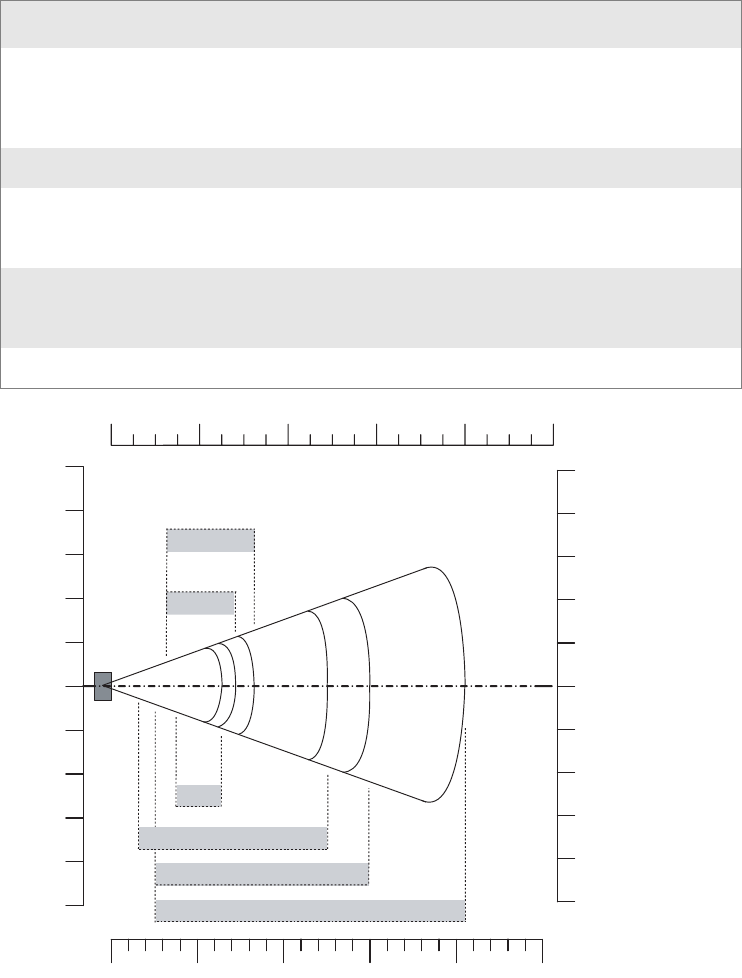
Chapter 1 — Using the Computer
6 PRELIMINARY - CN3 Mobile Computer User’s Manual
Reading Distances
Typical reading distances are done in an office environment using office
lights (4 lux). Minimum distances are measured in the dark (0 lux). Both
reading distances are provided in respective scan engine integration guides.
Contact your Intermec representative for more information.
The minimum standard reading distances for CN3 Computers built with
integrated scan engines are shown on the next pages. When correctly
mounted, an exit window reduces reading distances by about 4%.
EA11 Standard Minimum Reading Distances with 0.04” Setbacks
Symbology Density Minimum Distance Maximum Distance
Code 39 0.125 mm/ 5 mil
0.20 mm/ 8 mil
0.25 mm/ 10 mil
0.50 mm/ 20 mil
7.26 cm/ 2.86”
3.96 cm/ 1.56”
3.45 cm/ 1.36”
4.98 cm/ 1.96”
12.09 cm/ 4.76”
20.98 cm/ 8.26”
25.04 cm/ 9.86”
40.28 cm/ 15.86”
UPC/EAN 0.33 mm/ 13 mil 4.98 cm/ 1.96” 29.92 cm/ 11.66”
Datamatrix 0.191 mm/ 7.5mil
0.254 mm/ 10 mil
0.381 mm/ 15 mil
3.71 cm/ 2.46”
5.98 cm/ 1.96”
*
16.41 cm/ 6.46”
20.73 cm/ 8.16”
27.58 cm/ 10.86”
PDF417 0.168 mm/ 6.6 mil
0.254 mm/ 10 mil
0.381 mm/ 15 mil
6.25 cm/ 2.46”
4.47 cm/ 1.76”
4.98 cm/ 1.96”
13.87 cm/ 5.46”
21.74 cm/ 8.56”
33.43 cm/ 13.16”
* Minimum distance depends on symbology length and scan angle.
8"
4"
6"
2"
0"
2"
4"
in
6"
8"
10"
10"
cm
1
0
5
0
5
1
0
15
2
0
2
0
15
25
25
05040302010
0" 16"12"8"4"
PDF417 6.6 mils
0.125mm / 5mils
0.25 mm / 10 mils
0.5 mm / 20 mils
Data Matrix 7.5 mils
100% contrast UPC EAN

Chapter 1 — Using the Computer
CN3 Mobile Computer User’s Manual - PRELIMINARY 7
Using the Batteries
The CN3 Computer uses a 8.0 Watt-hour standard pack or 14.0 Watt-
hour extended pack replaceable Lithium-Ion (LiIon) battery. Standard
packs are of 2.2 A Hr, 3.7 VDC; and extended packs are of 4.0 A Hr, 3.7
VDC. You must fully charge the battery before you can use the CN3 Com-
puter. When you change the battery, a backup battery (super capacitor)
maintains your status, memory, and real-time clock for at least 5 minutes.
Dispose used battery packs promptly. Keep away from children. Contact
your Intermec representative for replacement batteries.
Several factors determine the life of your battery such as extreme tempera-
tures, input devices, and your usage.
The CN3 Computer contains an internal super capacitor, a temporary
power storage device, that protects state for up to five minutes. This is to
give you time to replace the battery pack before state is lost. Be sure to put
the computer in a suspend mode before doing so.
Charging and Installing the Battery
Make sure you fully charge either the standard or the extended battery pack
before you install it in your CN3 Computer. If temperatures are within
battery charging range, the standard battery pack takes four hours to
charge; the extended battery pack takes five hours.
You can charge the battery pack using:
• a CN3 Quad Battery Pack Charger
• a CN3 Single Dock spare battery pack charge slot
• a CN3 Computer with external power applied
The battery used in this device may present a fire or chemical burn haz-
ard if it is mistreated. Do not disassemble it, heat it above 100°C
(212°F) or incinerate it.
If you fail to replace the battery immediately, you may lose important
state or applications.
Note: If the CN3 Computer is not on external power and the battery pack
is removed, it will suspend when the battery pack is removed.
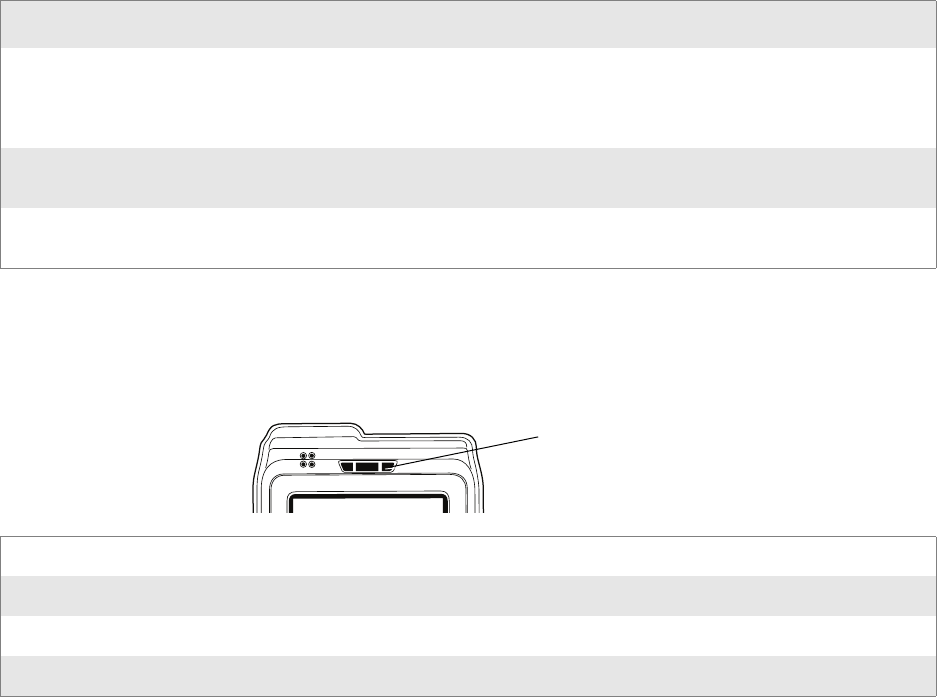
Chapter 1 — Using the Computer
8 PRELIMINARY - CN3 Mobile Computer User’s Manual
The charge/operating power can be applied to the CN3 Computer using
any of the following. For more information on these accessories, see
“Accessories for the CN3 Computer” on page 18.
• AC wall adapter
• a Magnetic Card Reader Snap-on
• a CN3 Single Dock
• a CN3 Multidock, either charge-only or Ethernet
• a Cigarette Lighter Adapter
To install the battery, insert the tabs on the charged battery into the CN3
Computer and snap the battery into place.
Maximizing Battery Life
Below are things that you can do to maximize the life of your battery.
Checking the Battery Status
The Battery Status LED above your CN3 display, as shown in the follow-
ing illustration, indicates the status of your battery. See the following table
to understand the meanings of the lights emitted from the LED.
When You Want To: Do This to Save Battery Power:
Operate the CN3 Computer and the Low
Battery status icon appears or the Battery
light comes on.
Press I to turn off the CN3 Computer. Remove the battery and insert
another fully charged battery as quickly as possible or you may lose
state. Or, you can insert the CN3 Computer into a powered CN3
Quad Battery Charger.
Stop using the CN3 Computer for five
minutes or longer.
Make sure the low battery icon is not on the screen and that the Battery
light is not turned on. Press I to turn off the CN3 Computer.
Store CN3 Computers for more than a day. Save your state and end your computer session, press I to turn off the
CN3 Computer, then insert a fully charged battery.
Steady Green Battery is more than 95% charged and unit is on a charger.
Blinking Red Battery is low.
Steady Red Main battery is on charge.
Steady Yellow The battery is either out of the unit or the pack temperature is too hot or too cold to charge.
Battery Status LED
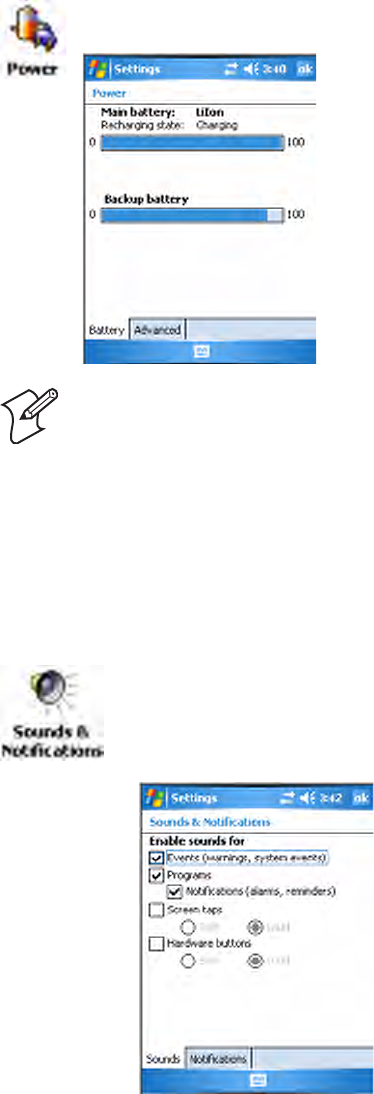
Chapter 1 — Using the Computer
CN3 Mobile Computer User’s Manual - PRELIMINARY 9
Adjusting the Beeper
For information about setting volume levels for screen taps, ActiveSync
alert noises, etc., tap Start > Help.
Enabling the Beeper
You can use the Power applet to view the status of this battery. Tap Start >
Settings > the System tab > the Power icon, then tap the Battery tab.
Note: The Backup battery option shown in the Battery tab refers to the
super capacitor used by the CN3 Computer to store energy.
1Tap Start > Settings > the Personal tab > the Sounds & Notifica-
tions icon, then tap the Sounds tab.
2Check for which features the CN3 Computer should enable sounds,
then tap ok to close.
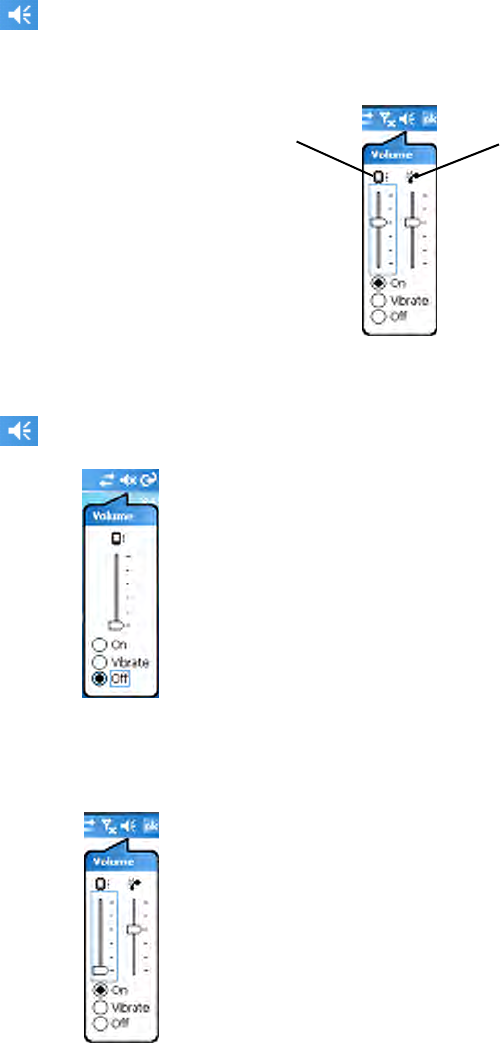
Chapter 1 — Using the Computer
10 PRELIMINARY - CN3 Mobile Computer User’s Manual
Disabling the Beeper
If your CN3 Computer has a built-in phone, tapping Off will disable both
the beeper and the phone. To disable just the beeper, drag the left slider bar
to its bottom position, like in the following illustration.
Intermec Settings Applet
Use the Intermec Settings applet to gather, view, and update device config-
uration settings. Information about the settings you can configure with the
Intermec Settings applet is in the Intermec Computer Command Reference
Manual (P/N: 073529) available online at www.intermec.com.
3Tap the Volume icon at the top of the screen, tap On, then move the
slider bar to your desired level. If your CN3 Computer comes with a
phone, then be sure to use the left slider bar for the volume and the
right slider bar for the phone.
To disable the beeper, tap the Volume icon, then drag the left slider to the
bottom, or tap Off. Note the change in the Vo l u m e icon.
Phone slider barVolume slider bar
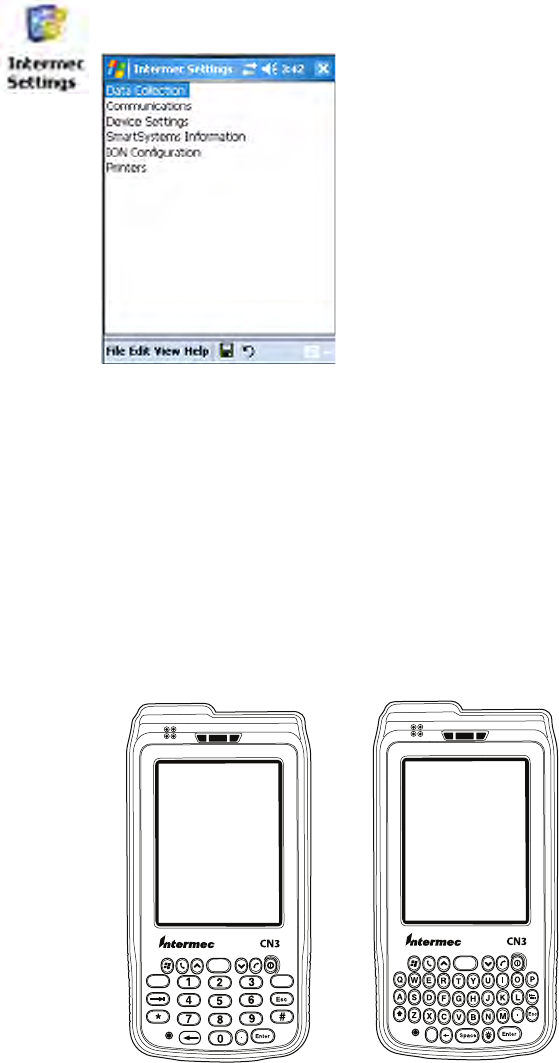
Chapter 1 — Using the Computer
CN3 Mobile Computer User’s Manual - PRELIMINARY 11
See the Data Collection Resource Kit in the Intermec Developer Library
(IDL) for information about data collection functions. The IDL is available
as a download from the Intermec web site at www.intermec.com/idl. Con-
tact your Intermec representative for more information.
Using the Keypad
Your CN3 Computer has either of the following keypad overlay options:
• The 26-key large numeric keypad is for applications that enter mainly
numeric data (0-9). This keypad also lets you enter special characters by
pressing color-coded key sequences.
• The 42-Key full alphabetic keypad is for applications that enter mainly
the entire alphabet and may need to enter numeric data (0-9). This key-
pad also provides special characters, symbols, and functions by pressing
color-coded key sequences.
Tap Start > Settings > the System tab > the Intermec Settings icon to
access the applet.
26-Key Large Numeric 42-Key Full Alphabetic
Chapter 1 — Using the Computer
12 PRELIMINARY - CN3 Mobile Computer User’s Manual
Using the Color-Coded Keys
Each keypad available for the CN3 Computer provides color-coded keys to
let you access additional characters, symbols, and functions printed on the
keypad overlay. Once you understand how to use the color-coded keys and
key sequences, you can access all of the additional features printed on the
keypad overlay. There are two color-coded modifier keys on the numeric
keypad: the orange B key and the green C key. The alphanumeric key-
pad just has the orange B color-coded modifier key.
You press and release the first key, then press and release the second key to
access the color-coded character or function printed above a key. Note that
there are several hidden characters (such as < or >) on each CN3 keypad
that require using the color-coded keys to access them.
Capitalizing All Characters
To type all alphanumeric characters as uppercase letters, you can enable the
Caps Lock feature on the CN3 keypad. To enable Caps Lock:
•On the alphabetic keypad, press the B key, then the Shift key. Press the
same key sequence to disable the Caps Lock.
•On the numeric keypad, press the C key, then the A (backspace) key.
Using the Power (I/O) Switch
When you press the power switch, you actually suspend the CN3 Com-
puter. In this mode, the display and backlight are turned off. This power-
saving feature is to prolong battery life.
Using the Screen
The CN3 Computer has a 3.5” diagonal, 240x320 pixel (QVGA) transflec-
tive TFT-LCD 64K color display. The screens support Unicode characters,
user-programmable fonts, and bitmap graphics.
• The toolbar displays the Start flag, the connectivity icon, the volume
icon, and the time and next appointment.
• The desktop displays shortcuts to some of the applications installed on
the CN3 Computer.
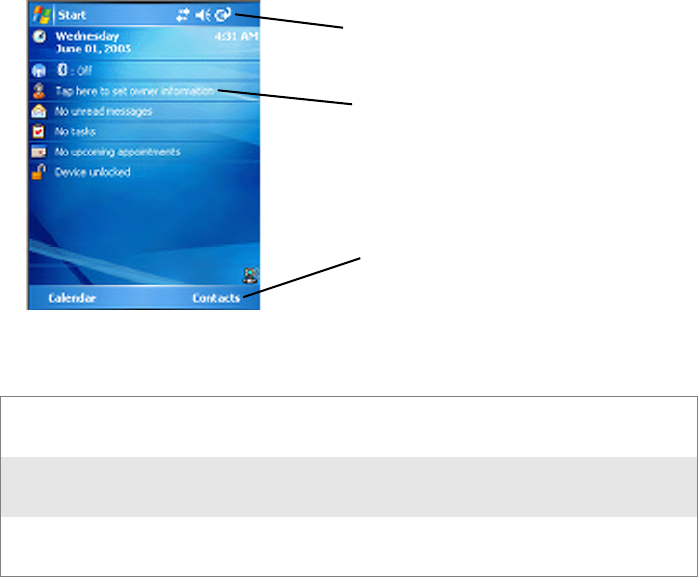
Chapter 1 — Using the Computer
CN3 Mobile Computer User’s Manual - PRELIMINARY 13
• The taskbar displays the onscreen keyboard icon, Pocket PC links, and
icons to any applications that are running, yet are hidden.
Your CN3 Computer has a stylus for selecting items and entering informa-
tion. Use the stylus in place of a mouse.
Software Tools
SmartSystems Foundation Console (www.intermec.com/SmartSystems)
This free download tool includes a management console that provides a
default method to configure and manage Intermec devices “out-of-the-
box,” without the purchase of additional software licenses. This is for con-
figuring and deploying multiple devices or managing multiple licenses.
You can access the SmartSystems Foundation from the Intermec web site at
www.intermec.com/SmartSystems.
Intermec Resource Kits (www.intermec.com/IDL)
Resource Kits provide tools that build applications using the features of
Intermec devices. Resource kits include: Bluetooth, Communications, Data
Collection, Device Settings, Mobile Gadgets, Printing, and RFID.
You can use resource kits, software development information, and other
programming support in the Intermec Developer Library available from the
Intermec web site at www.intermec.com/IDL.
Tap Touch the screen once with the stylus to select options, close appli-
cations, launch applications, or launch menus from the taskbar.
Drag Hold the stylus on the screen and drag across the screen to select
text and images.
Tap and hold Tap and hold the stylus on an icon to see a list of actions available
for the item. On the menu that appears, tap the action to perform.
Desktop
Taskbar
Toolbar
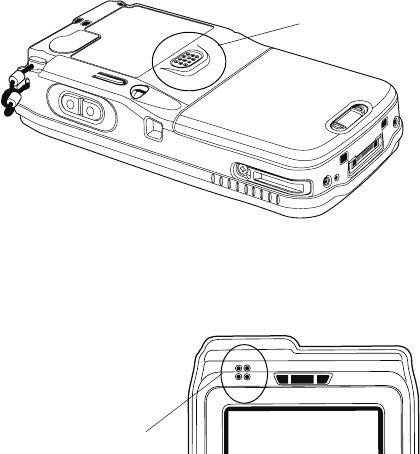
Chapter 1 — Using the Computer
14 PRELIMINARY - CN3 Mobile Computer User’s Manual
Using the Speakers
The high-volume speaker on the back and the top of the CN3 Computer,
is capable of variable volume levels. This speaker is capable of reproducing
voice and WAV files, and is used primarily to convey status tones. There is
a separate volume control in the toolbar at the top of the display. You can
also control the volume using the Intermec Settings applet. Information on
this control and applet are on the next page.
The front speaker is a full-voice range speaker of cell-phone quality with a
separate volume control. See the following paragraph for information about
this volume control.
Warning: Do not place the speaker next to your ear when the speaker
volume is set to “Loud” (maximum), or you may damage your hearing.
High-volume speaker on center, back
Front Speaker
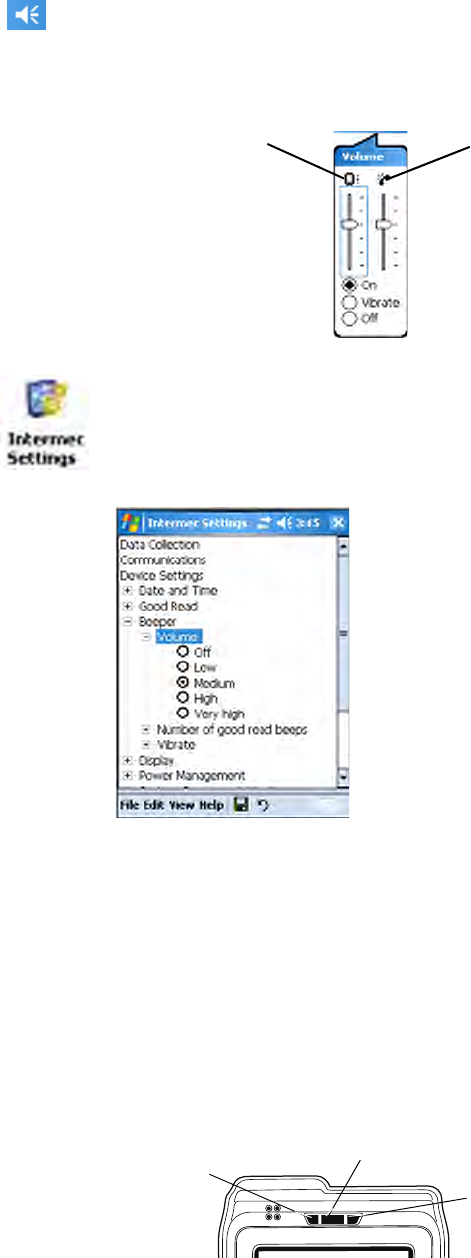
Chapter 1 — Using the Computer
CN3 Mobile Computer User’s Manual - PRELIMINARY 15
Enabling the Speaker and Adjusting the Volume
Using the Status LEDs
The Good Scan LED on the left shows green when the CN3 Computer
successfully decodes a bar code.
The center System LED shows blue when the CN3 Computer has success-
fully loaded and activated the TE 2000 application.
The Battery Status LED on the right alerts you to the status of your battery.
If this shows red, the battery needs replacing. Yellow means the battery is
low and needs recharging. Green means the battery is good.
To enable the speaker and adjust the volume, tap the Volume icon at the
top of the screen. Tap On, then move the system volume slider to the
desired volume level. Up is louder, down is quieter. If your CN3 Computer
comes with a phone, then be sure to use the left slider bar for the volume
and the right slider bar for the phone.
You can also enable the speaker and adjust the volume with the Intermec
Settings applet. Tap Start > Settings > the System tab > the Intermec Set-
tings icon, then tap (+) to expand Device Settings > Beeper > Volume. Tap
any of the options other than “Off” to enable and adjust. To disable the
speaker, tap the Off option.
Phone slider barVolume slider bar
Notification
Battery Status LED
Good Scan LED and Intermec Ready-to-Work Indicator
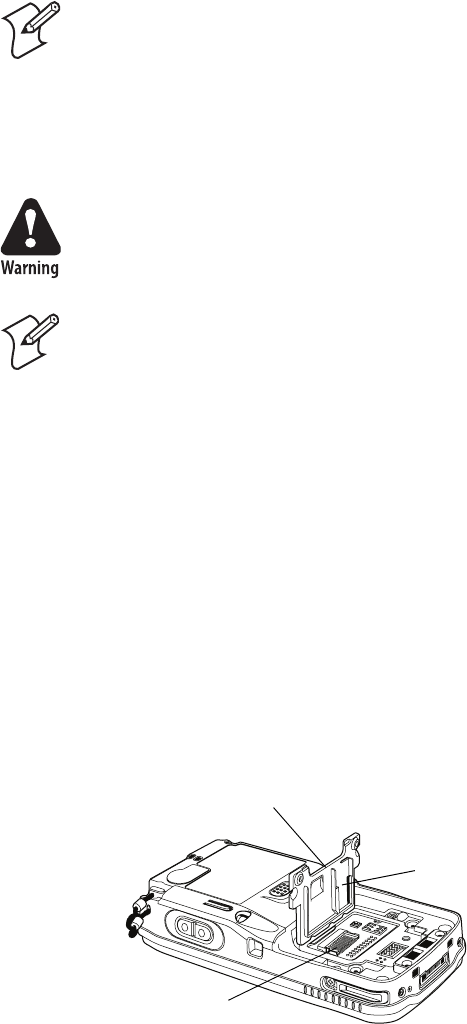
Chapter 1 — Using the Computer
16 PRELIMINARY - CN3 Mobile Computer User’s Manual
Using the Storage Card
You can use a miniature Secure Digital (mini-SD) card to increase file stor-
age and install software. The mini-SD card slot is located under a door that
is beneath the battery pack. Remove the two screws holding the door to
reach the mini-SD card.
To Insert the Mini-SD Card
1Press the power switch to suspend the CN3 Computer, then remove the
battery pack from the back of the CN3 Computer.
2Remove the two screws on the miniSD/SIM card slot door. Note the
screws to this door are to be torqued to 1.5 in-lbs.
3Gently lift the door to the card slot, then with the metal contacts facing
down, insert the mini-SD card into the card slot connector until the card
lifts up from the floor of the card slot.
4Press the miniSD/SIM card slot door down, insert the two screws, rein-
sert the battery pack, then press the power switch.
Once the door to the mini-SD is opened (for changing, installing, or
removing the SIM or mini-SD card); a cold-boot is performed.
To Remove the Mini-SD Card
Press the power switch to suspend the CN3 Computer. Remove the battery
pack, then the two screws on the miniSD/SIM card slot door. Remove the
mini-SD card from the CN3 Computer.
Note: MultiMediaCards (MMCs) and CompactFlash (CF) storage cards
are not supported in the CN3 Computer.
Warning: You can corrupt your mini-SD card if you do not follow
these installation and removal procedures exactly. Before installing a
mini-SD card, inspect the gasket on the door for any damage or wear,
and replace the door if any damage or wear is found
Note: The CN3 Computer will reset if the miniSD/SIM door is opened.
The screws to this door must be in place to ensure normal operation.
mini-SD/SIM door
mini-SD card slot
SIM card slot

Chapter 1 — Using the Computer
CN3 Mobile Computer User’s Manual - PRELIMINARY 17
Setting the Vibrator
To set your CN3 Computer to vibrate, tap the Volume icon at the top of
the screen, then tap Vibrate. If your CN3 Computer has a built-in phone,
this sets both the volume and the phone to vibrate. Note the icon change.
You can also set the vibrate using the Intermec Settings applet. Tap
Start > Settings > the System tab > the Intermec Settings icon, then tap
(+) to expand Device Settings > Beeper > Vibrate, then tap Vibrate. To
disable the vibrate, tap the Beeper option.
Or use the Sounds & Notifications applet to set the vibrator. Tap Start
> Settings > the Personal tab > the Sounds & Notifications icon, then
tap the Notifications tab. Select the event from the Event drop-down
list, check Vibrate, then tap ok to close.

Chapter 1 — Using the Computer
18 PRELIMINARY - CN3 Mobile Computer User’s Manual
Wireless Network Support
Radios are installed at the factory and cannot be installed by a user. The
CN3 Computer must be serviced to install or replace radios. Contact your
Intermec representative for more information. See Chapter 5, “Network
Support” for information about supported radios.
Accessories for the CN3 Computer
These are a few of the accessories available for your CN3 Computer. Con-
tact your local Intermec representative about ordering these and other
accessories that may be available.
Quad Battery Charger
Use the Quad Battery Charger to charge up to four CN3 battery packs.
Charge-Only Multidock
Use the Charge-Only Multidock to hold up to four CN3 Computers with
batteries installed, charge batteries, and provide power to CN3 Computers.
Ethernet Multidock
Use the Ethernet Multidock to hold up to four CN3 Computers with bat-
teries installed. The multidock charges the batteries, provides power to the
CN3 Computers, and provides one Ethernet connector.
Single Dock
Use the Single Dock to hold a CN3 Computer with its battery installed,
charge a spare battery pack, charge the main battery, and provide power to
the CN3 Computer. The dock has USB host and client connectors, a mod-
ule to convert the USB host to Ethernet, and a module to convert the USB
host to modem plug over the USB host connector.
Belt
Use this item to carry your CN3 Computer if it has either a 1D linear
imager or a 2D imager, and also accommodates a handle. This supports
either right- or left-handed use.
Note: Changes or modifications not expressly approved by Intermec could
void the user's authority to operate the equipment.
Chapter 1 — Using the Computer
CN3 Mobile Computer User’s Manual - PRELIMINARY 19
Physical and Environmental Specifications
This section contains technical information, available features, and options.
Physical Dimensions (excluding overmold)
Length: 16.0 cm (6.3”)
Width: 8.1 cm (3.2”)
Height: 3.3 cm (1.3”)
Weight: Non-WAN units - 14 oz
WAN units w/standard battery - 15 to 16 oz
WAN units w/extended battery - 16 to 17 oz
Hardware
Microprocessor: Intel XScale PXA270
Application Processor: 520 MHz RAM
Memory: 128 MB RAM
Persistent Storage: 128 MB NAND Flash, provides onboard
non-volatile storage of applications and data
Removable Storage: mini-SD Card Slot, user-accessible
Keypad: 14-key with large numeric keys or
56-key with full alphanumeric keys;
both with LED backlighting
Scanner Options: EA11 scan engine or Color Camera
Operating System
Microsoft Windows Mobile 5.0
Software
Development Environments:Embedded Visual C++ 4.0,
.NET Compact Framework (VB. NET, C#)
IDL: Integrates with leading development
environments; supports device-specific
features and bar code scanning
Browser support: Internet Explorer 6-compatible
Bar Code Scanning
Options of Integrated 2D Area Imager or 1D & PDF417 Linear Imager
Supports all popular 1D and 2D symbologies including Australian Post,
British Post, Codabar, Codablock A, Codablock F, Code 11, Code 2 of 5,
Code 39, Code 93, Code 93i, Code 128, Datamatrix, Dutch Post, ISBT
128, Interleaved 2 of 5, Macro 2 of 5, Matrix 2 of 5, Maxicode, Micro
PDF417, MSI, PDF417, Planet, Plessey, Postnet, QR Code, RSS 14, RSS
Expanded, RSS Limited, Telepen, TLC39, UCC-EAN Composite Code,
UPC/EAN
Standard Communications
USB host, USB client, Bluetooth, 802.11b/g, GPRS, CDMA, GPS

Chapter 1 — Using the Computer
20 PRELIMINARY - CN3 Mobile Computer User’s Manual
Wireless LAN
Standards Compliant: IEEE 802.11g (2.4 GHz - OFDM)
IEEE 802.11b (2.4 GHz - DSSS)
Data Rates: Up to 54 Mbps for 802.11g
Up to 11 Mbps for 802.11b
Radio Power Output: 100 mW
Security: WEP, WPA, 802.11i, 802.1x
(EAP-TLS, TTLS, LEAP, PEAP, EAP-FAST)
Certifications: Wi-Fi, WPA, WPA2, Cisco Compatible
Extensions
Device Management
SmartSystems™ Support: Centralized remote support capability;
configures, updates, and maintains single
devices or entire populations;
real-time or batch, wired or wireless.
Based on Wavelink Avalanche™ with
Intermec value added utilities.
Power Specifications
Operating: Removable, rechargeable LiIon
batteries; AB8 standard pack, 3.7 VDC,
2.2 AHr, (8 W-hr - 4 hr charge time); or AB9
extended pack, 3.7 VDC, 4.0 A Hr, (14 W-hr
- 5 hr charge time); battery life is application-
dependent; recharging cycle is 4 hours or less
Backup: Super capacitor supplies 5 minutes bridge time
while replacing the AB8 or AB9 Battery
Electrical Specifications
External Charge Power: 5 V +/- 5% @ 3.5 A max. (18 W max.)
Environment
Operating temperature: -10° to 50°C (14° to 122°F)
Storage temperature: -20° to 70°C (-13° to 158°F)
Humidity: 5% to 95% noncondensing
Electrostatic Discharge: +8kV Contact Discharge; +15kV Discharge
Rain and Dust Resistance: IP54 compliant
Drop Survival: Multiple 4 ft (1.2 m) drops to steel or concrete
Screen Specifications
Transflective TFT; QVGA Color w/touch panel; 240x320 pixels; 8.9 cm
(3.5 in) diagonal active area; 5-level LED backlight control with settings
Regulatory Approvals
UL and cUL Listed, UL 60950 and UL 1604 and CSA 22.2 No. 157, FCC
Part 15, TUV, CE mark

CN3 Mobile Computer User’s Manual - PRELIMINARY 21
2Windows Mobile
This chapter introduces Microsoft Windows Mobile 5.0 for Pocket PC.
While using the CN3 Mobile Computer, keep these key points in mind:
•Tap Start on the navigation bar, located at the top of the screen, to
quickly move to programs, files, and settings. Use the command bar at
the bottom of the screen to perform tasks in programs. The command
bar includes menus, icons, and the onscreen keyboard.
• Tap and hold an item to see a pop-up menu containing a list of actions
you can perform. Pop-up menus give you quick and easy access to the
most common actions.
Below is a list of Windows Mobile components described in this chapter.
Tap Start > Help, then select a topic on your CN3 Computer to find addi-
tional information on Windows Mobile components.
Windows Mobile 5.0 Components
Microsoft ActiveSync (page 36)
Microsoft Pocket Outlook (page 38)
Word Mobile (page 60)
Excel Mobile (page 62)
PowerPoint Mobile (page 64)
Windows Media Player for Windows Mobile (page 65)
Using Internet Explorer Mobile (page 68)

Chapter 2 — Windows Mobile
22 PRELIMINARY - CN3 Mobile Computer User’s Manual
Software Builds
See “Learning Software Build Versions” on page 3 to determine which
Intermec build of Windows Mobile 5.0 is on your unit.
Where to Find Information
This chapter describes your CN3 Computer hardware, provides an over-
view of the programs on your CN3 Computer, and explains how to con-
nect your CN3 Computer to a desktop, a network, or the Internet. For
instructions on setting up your CN3 Computer and installing ActiveSync,
see the Quick Start Guide. The following is a guide to more information to
assist you use your CN3 Computer.
Windows Mobile and many of the technologies supported by the CN3
Computer are not from Intermec. Many of the utilities and features on a
Windows Mobile device come directly from Microsoft without any modifi-
cation from Intermec. There may be certain Microsoft-specific issues that
Intermec would not be able to support, so contact our front-line support
personnel to determine the best source of assistance.
Use these URLs for additional information about Microsoft Windows
Mobile (Pocket PC):
•msdn.microsoft.com/support/
•support.microsoft.com/
•news.microsoft.com (a free support option)
Basic Usage
Learning to use your CN3 Computer is easy. This section describes the
basic concepts of using and customizing your CN3 Computer.
For information on: See this source:
Programs on your mobile computer. This chapter and mobile computer Help. To view Help, tap
Start > Help, then select a topic.
Additional programs that can be installed on the
mobile computer.
The Windows Mobile Companion CD.
Connecting to and synchronizing with a desktop. The Quick Start Guide or ActiveSync Help on your desktop.
To view Help, click Help > Microsoft ActiveSync Help.
Last-minute updates and detailed technical informa-
tion.
The Read Me files, located in the Microsoft ActiveSync folder
on the desktop and on the Windows Mobile Companion CD.
Up-to-date information on your Windows Mobile. www.microsoft.com/windowsmobile/resources/communi-
ties/default.mspx
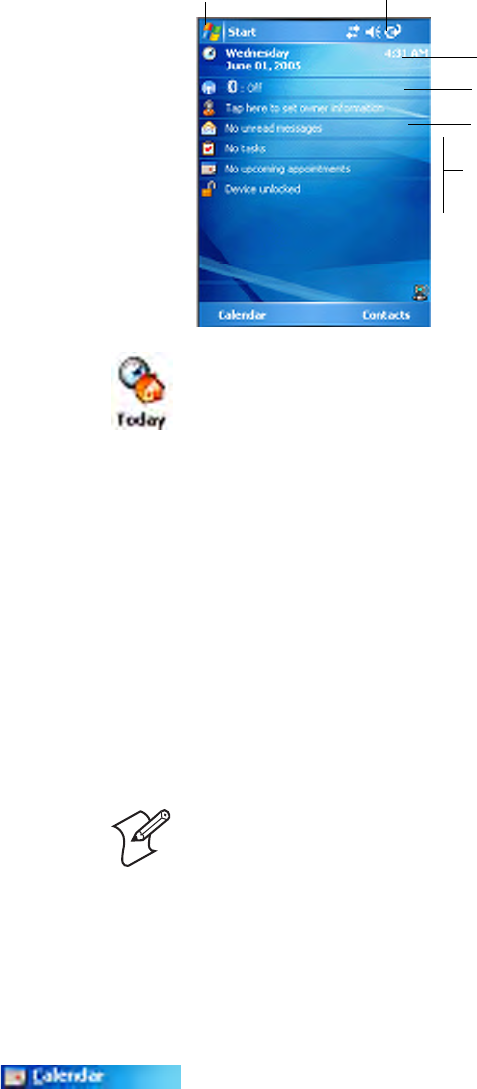
Chapter 2 — Windows Mobile
CN3 Mobile Computer User’s Manual - PRELIMINARY 23
Today Screen
When you turn on your CN3 Computer for the first time each day (or after
four hours of inactivity), you see the Tod ay screen. You can also display it by
tapping the Start flag at the top left of your display and then To d a y. On
the Today screen, you can see important information for the day.
Programs
You can switch from one program to another by selecting it from the Start
menu. (You can customize which programs you see on this menu. For
information, see “Adjusting Settings” on page 33.) To access some pro-
grams, tap Start > Programs, and then the program name.
You can also switch to some programs by pressing a program icon. Your
CN3 Computer has one or more program icons located on the front or side
of the computer. The icons on the icons identify the programs to which
they switch.
The following is a partial list of programs that are on your CN3 Computer,
in the order they appear in the Start menu. Look on the Windows Mobile
Companion CD for additional programs that you can install onto your CN3
Computer.
To customize what is displayed on the Today screen, including the back-
ground image, tap Start > Settings > the Personal tab > the To d a y icon.
Status icons display information such as low batteries or when the CN3
Computer is connected to a desktop or to the Internet. You can tap an icon
to open the associated setting or program.
Note: Some programs have abbreviated labels for check boxes and drop-
down menus. To see the full spelling of an abbreviated label, tap and hold
the stylus on the label. Drag the stylus off the label so that the command is
not carried out.
Keep track of your appointments and create meeting requests.
Tap to start a program Tap and hold to change time format
Tap to change date and time
Tap to change owner information
Tap to review your email
Your day at a glance. Tap to open an associated
program
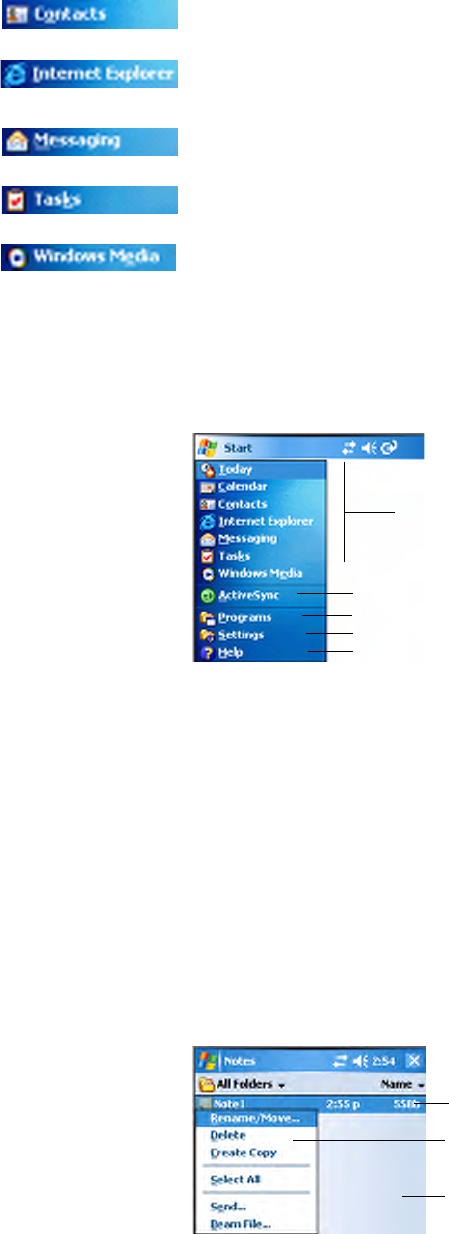
Chapter 2 — Windows Mobile
24 PRELIMINARY - CN3 Mobile Computer User’s Manual
Navigation Bar and Command Bar
The navigation bar is located at the top of the screen. It displays the active
program and current time, switch to programs, and close screens.
Use the command bar at the bottom of the screen to perform tasks in pro-
grams. The command bar includes menu names, functions, and the Input
Panel icon, when needed. To create a new item in the current program, tap
New. To see the name of a icon, tap and hold the stylus on the icon. Drag
the stylus off the icon so that the command is not carried out.
Pop-up Menus
Use pop-up menus to quickly perform an action on an item. For example,
you can use a pop-up menu to delete or make a copy of an item. To access
a pop-up menu, tap and hold the item on which you want to perform the
action. When the menu appears, tap the action you want to perform, or tap
anywhere outside the menu to close the menu without performing the
action.
Keep track of your friends and colleagues.
Browse Web and WAP (Wireless Application Protocol) sites, and down-
load new programs and files from the Internet.
Send and receive e-mail messages.
Keep track of your tasks.
Play digital audio and video files that are stored on your CN3 Computer
or on a network.
Tap to switch to a program
Tap to see more programs
Tap to change device settings
Tap to see a Help topic for the current screen
Select from up to six recent accessed programs
Tap and hold to display the pop-up menu
Lift the stylus and tap the action you want
Tap outside to close without performing an action
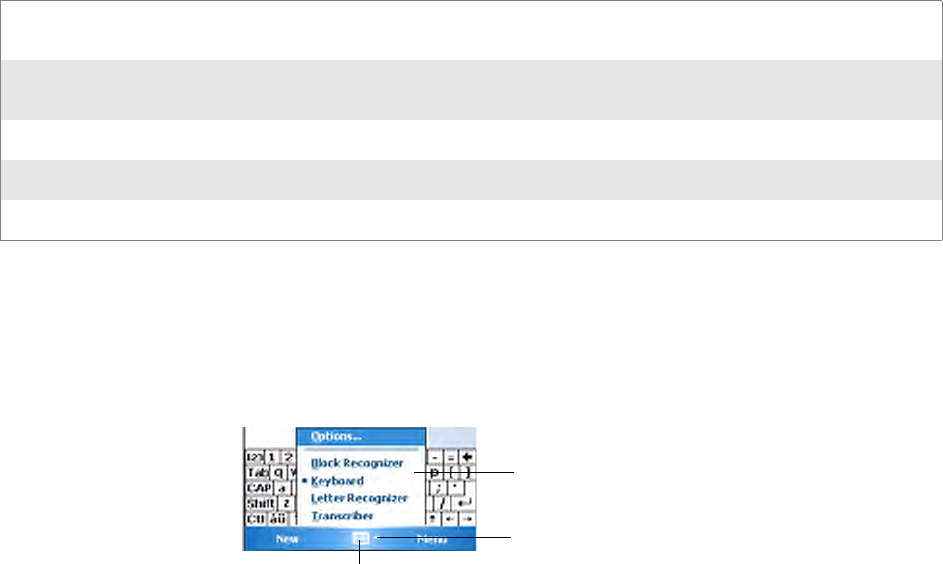
Chapter 2 — Windows Mobile
CN3 Mobile Computer User’s Manual - PRELIMINARY 25
Notifications
When you have something to do, your CN3 Computer notifies you in a
variety of ways. For example, if you have set up an appointment in Calen-
dar, an e-mail message arrives, or a friend sends you an instant message, you
are notified in any of the following ways: a message box appears on the
screen, a sound (which you can specify) is played, a light flashes on your
CN3 Computer, or the CN3 Computer vibrates. You can choose the noti-
fication types.
Entering Information
You can enter information on your CN3 Computer in several ways,
depending on the type you have and the program you are using:
Use the input panel to enter information in any program on your CN3
Computer. You can either type using the onscreen keyboard or write using
Block Recognizer, Letter Recognizer, or Transcriber. In either case, the
characters appear as typed text on the screen.
To show or hide the input panel, tap the Input Panel icon. Tap the arrow
next to the Input Panel icon to see your choices.
When you use the input panel, your CN3 Computer anticipates the word
you are typing or writing and displays it above the input panel. When you
tap the displayed word, it is inserted into your text at the insertion point.
Synchronizing Using Microsoft ActiveSync, synchronize or copy information between your desktop and CN3
Computer. For more information on ActiveSync, see ActiveSync Help on your desktop.
Typi n g Using the input panel, enter typed text into the CN3 Computer. Do this by tapping keys on the
onscreen keyboard or by using handwriting recognition software.
Writing Using the stylus, write directly on the screen.
Drawing Using the stylus, draw directly on the screen.
Recording Create a stand-alone recording or embed a recording into a document or note.
Select an input method
Tap to see your choices
Input Panel icon

Chapter 2 — Windows Mobile
26 PRELIMINARY - CN3 Mobile Computer User’s Manual
The more you use your CN3 Computer, the more it learns to anticipate.
Typing With the Onscreen Keyboard
Tap the input panel arrow, then tap Keyboard. On the soft keyboard that is
displayed, tap the keys with your stylus.
• To type a single uppercase letter or symbol, tap the Shift key. To tap
multiple uppercase letters or symbols, tap the CAP key.
• To convert a letter to uppercase, tap, and hold the stylus on the letter
and drag up.
• To add a space, drag the stylus to the right across at least two keys.
• To backspace a character, drag the stylus to the left across multiple keys.
• To insert a carriage return, tap and hold the stylus anywhere on the key-
board and drag down.
To change word suggestion options, such as the number of words suggested
at one time, tap Start > Settings > the Personal tab > Input > the Word
Completion tab.
Tap a text box to display the input panel
Tap to insert anticipated word
Tap characters on the onscreen keyboard to enter them

Chapter 2 — Windows Mobile
CN3 Mobile Computer User’s Manual - PRELIMINARY 27
To use larger keys, tap the input panel arrow, tap Options, select “Key-
board” from the Input method drop-down list, then select Large keys.
Using Block Recognizer
Character recognition software gives you a fast and easy method for enter-
ing information in any program on your CN3 Computer. Letters, num-
bers, and punctuation you write are translated into typed text.
Tap the input panel arrow, then tap Block Recognizer. Write a letter in the
box. When you write a letter, it is converted to typed text that appears on
the screen.
For specific instructions on using Block Recognizer, with Block Recognizer
open, tap the question mark next to the writing area.
Using Letter Recognizer
With Letter Recognizer, you can write letters using the stylus just as you
would on paper.
Tap the input panel arrow, then tap Letter Recognizer. Write a letter in the
box. When you write a letter, it is converted to typed text that appears on
the screen. For specific instructions on using Letter Recognizer, with Letter
Recognizer open, tap the question mark next to the writing area.
Using Transcriber
With Transcriber, you can write anywhere on the screen using the stylus
just as you would on paper. Unlike Letter Recognizer and Block Recog-
nizer, you can write a sentence or more of information. Then, pause and let
Transcriber change the written characters to typed characters.
Tap for assistance
Tap for assistance
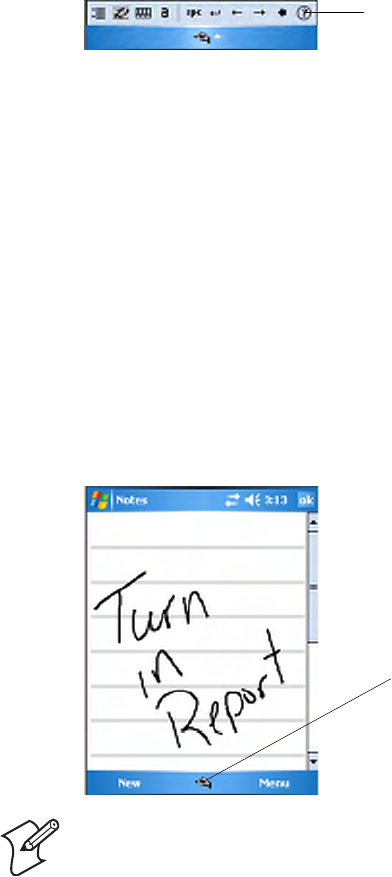
Chapter 2 — Windows Mobile
28 PRELIMINARY - CN3 Mobile Computer User’s Manual
Tap the input panel arrow, then tap Transcriber. Tap ok, then write any-
where on the screen.
For specific instructions on using Transcriber, with Transcriber open, tap
the question mark in the lower, right-hand corner of the screen.
Selecting Typed Text
If you want to edit or format typed text, you must select it first. Drag the
stylus across the text you want to select.
You can cut, copy, and paste text by tapping and holding the selected words
and then tapping an editing command on the pop-up menu, or by tapping
the command under Menu.
Writing on the Screen
In any program that accepts writing, such as the Notes program, and in the
Notes tab in Calendar, Contacts, and Tasks, you can use your stylus to
write directly on the screen. Write the way you do on paper. You can edit
and format what you have written and convert the information to text at a
later time. Tap the Pen icon to switch to writing mode. This action displays
lines on the screen to help you write
Selecting the Writing
If you want to edit or format writing, you must select it first.
1Tap and hold the stylus next to the text you want to select until the
insertion point appears.
2Without lifting, drag the stylus across the text you want to select.
If you accidentally write on the screen, tap Menu > Undo and try again.
You can also select text by tapping the Pen icon to deselect it and then
dragging the stylus across the screen.
Note: Some programs that accept writing may not have the Pen icon. See
documentation for that program to see how to switch to writing mode.
Tap for assistance
Tap to use your stylus like a pen
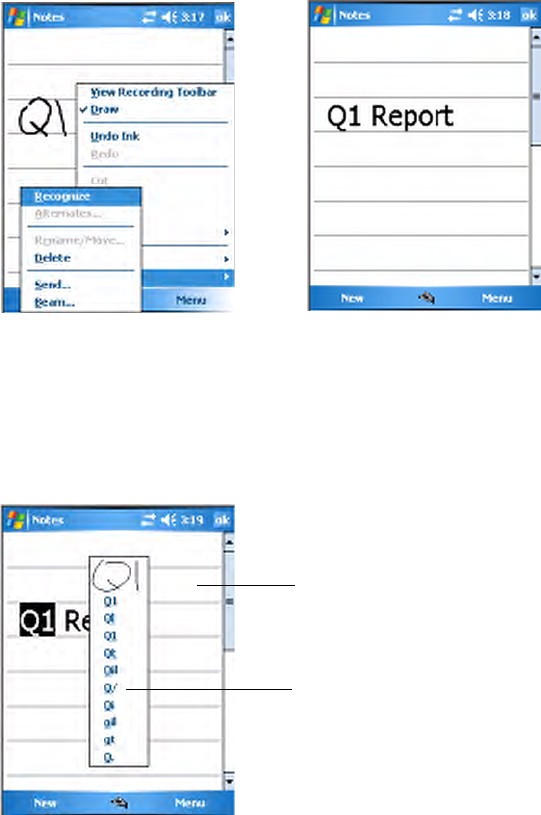
Chapter 2 — Windows Mobile
CN3 Mobile Computer User’s Manual - PRELIMINARY 29
You can cut, copy, and paste written text in the same way you work with
typed text: tap and hold the selected words and then tap an editing com-
mand on the pop-up menu, or tap the command under Menu.
Converting Writing to Text
You can convert words you write in print or cursive to text by tapping
Menu > To o l s > Recognize. If a word is not recognized, it stays in its origi-
nal form.
If you want to convert only certain words, tap Pen to disable the writing
function, tap twice over the word or phrase to highlight, then tap Menu >
Tools > Recognize.
If the conversion is incorrect, you can choose different words from a list of
alternates or return to the original writing. To do so, tap and hold the
incorrect word (tap one word at a time). On the pop-up menu, tap Alter-
nates. Tap the word use from the menu with a list of alternate words, or tap
the writing at the top of the menu to return to the original writing.
Tips for getting good recognition:
• Write neatly.
• Write on the lines and draw descenders below the line. Write the cross of
the “t” and apostrophes below the top line so they are not confused with
the word above. Write periods and commas above the baseline.
Before Recognition After Recognition
Tap to return to the original writing
Or tap the word you want to use
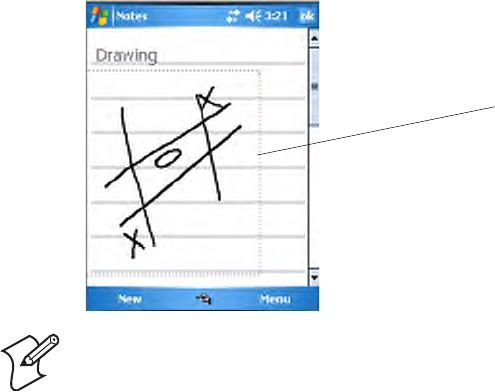
Chapter 2 — Windows Mobile
30 PRELIMINARY - CN3 Mobile Computer User’s Manual
• For better recognition, try increasing the zoom level to 300% by select-
ing Menu > Zoom. Recognition is not good under a 150% zoom.
• Write the letters of a word closely and leave big gaps between words so
that the CN3 Computer can easily tell where words begin and end.
• Hyphenated words, foreign words that use special characters such as
accents, and some punctuation cannot be converted.
• If you add writing to a word to change it (such as changing a “3” to an
“8”) after you attempt to recognize the word, the writing you add is not
included if you attempt to recognize the writing again.
Drawing on the Screen
You can draw on the screen in the same way that you write on the screen.
The difference between writing and drawing on the screen is how you select
items and how they are edited. For example, you can resize selected draw-
ings, while you cannot resize writing.
Creating a Drawing
Select Menu > Draw, then draw a line to initiate a drawing box. Subse-
quent strokes in or touching the drawing box become part of the drawing.
Selecting a Drawing
If you want to edit or format a drawing, you must select it first. Tap and
hold the stylus on the drawing until the selection handle appears. To select
multiple drawings, deselect the Pen icon and then drag to select the draw-
ings you want.
You can cut, copy, and paste selected drawings by tapping and holding the
selected drawing and then tapping an editing command on the pop-up
menu, or by tapping the command under Menu. To resize a drawing, make
sure the Pen icon is not selected, and drag a selection handle.
Note: You may want to change the zoom level so that you can easily work
on or view your drawing. Tap Menu > Zoom, then select a zoom level.
The drawing box indicates the boundaries of the drawing
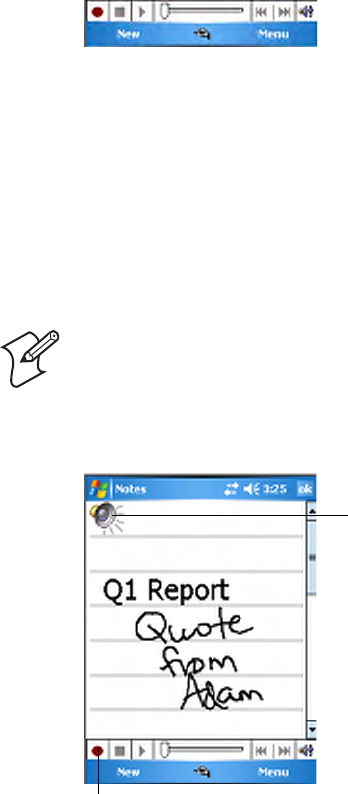
Chapter 2 — Windows Mobile
CN3 Mobile Computer User’s Manual - PRELIMINARY 31
Recording a Message
In any program where you can write or draw on the screen, you can also
quickly capture thoughts, reminders, and phone numbers by recording a
message.
In the Messaging program, you can add a recording to an e-mail message.
In Calendar, Tasks, and Contacts, you can include a recording in the Notes
tab. In the Notes program, you can create a stand-alone recording or add a
recording to an open note.
Tap Menu > View Recording Toolbar to add the recording toolbar to the
bottom of the screen.
1Hold the CN3 Computer’s microphone near your mouth or source of
sound.
2Tap the red circle to start your recording.
3Tap the black box when finished. If you are recording in an open note,
an icon appears in the note, like in the following sample. If you are creat-
ing a stand-alone recording, it appears in the note list.
4To play a recording, tap the recording icon in the open note or tap the
recording in the note list.
To play a recording, tap it in the list or tap its icon in the note.
Using My Text
When using Messaging, use My Text to quickly insert preset or frequently
used messages into the text entry area. To insert a message, tap Menu > My
Text , then select a message.
Note: To quickly create a recording, hold down the Record hardware but-
ton. When you hear the beep, begin your recording. Release the button
when you are finished. The new recording is stored in the open note or as a
stand-alone recording if no note is open.
Tap to begin recording
Indicates an embedded recording

Chapter 2 — Windows Mobile
32 PRELIMINARY - CN3 Mobile Computer User’s Manual
• To quickly add common messages, tap Menu > My Text and tap a
desired message.
• To edit a My Text message, tap Menu > My Text > Edit My Text Mes-
sages. Tap the message you want to edit and enter new text at the bot-
tom of the screen.
Finding and Organizing Information
You can use the File Explorer to find files on the CN3 Computer, and orga-
nize these files into folders, and move files using the cut or copy-and-paste
methods. Tap Start > Programs > the File Explorer icon.
For future use, this is added to your Start menu in the Recent Programs
area, via Start > File Explorer.
Tap New Folder to create a new folder
Tap a folder to open it
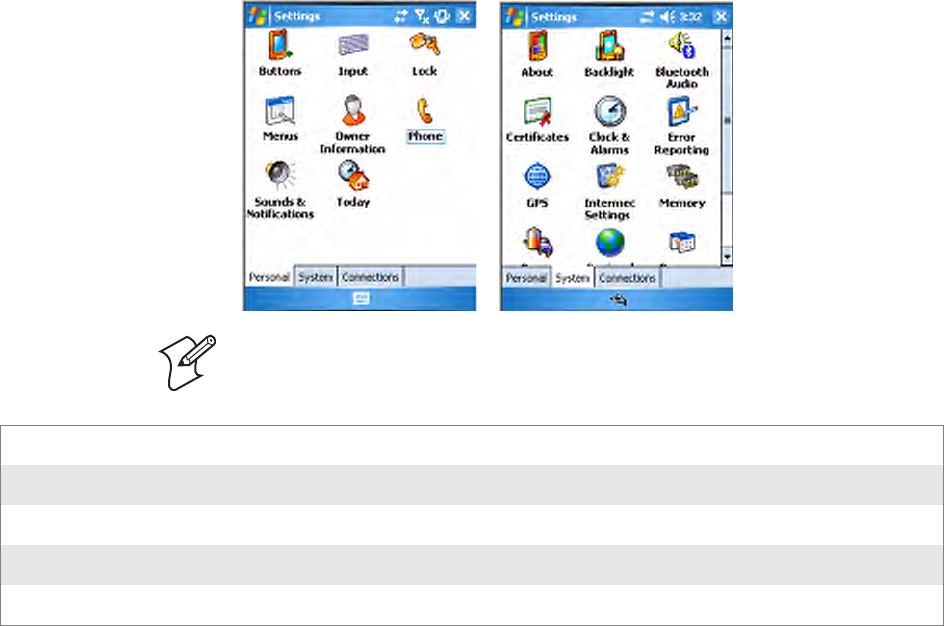
Chapter 2 — Windows Mobile
CN3 Mobile Computer User’s Manual - PRELIMINARY 33
Customizing Your CN3 Computer
You can customize by adjusting settings and installing additional software.
Adjusting Settings
To adjust settings to fit the way you work, tap Start > Settings > either the
Personal tab or the System tab located at the bottom of the screen.
Adding or Removing Programs
Programs added to your CN3 Computer at the factory are stored in ROM
(Read Only Memory). You cannot remove this software, and you cannot
accidentally lose ROM contents. ROM programs can be updated using
special installation programs with a *.XIP extension. All other programs
and data files added to your CN3 Computer after factory installation are
stored in RAM (Random Access Memory).
You can install any program created for the CN3 Computer, as long as
there is enough memory. A popular place to find software for your CN3
Computer is on the Windows Mobile Web site (www.microsoft.com/win-
dowsmobile/resources/communities/default.mspx).
Menus To customize what appears on the Start menu.
Owner Information To enter your contact information.
Today To customize the look and information displayed on the Today screen.
Clock & Alarms To change the time or to set alarms.
Power To maximize battery life.
Note: The Phone applet in the Personal tab is available only on CN3
Computers with built-in phones.
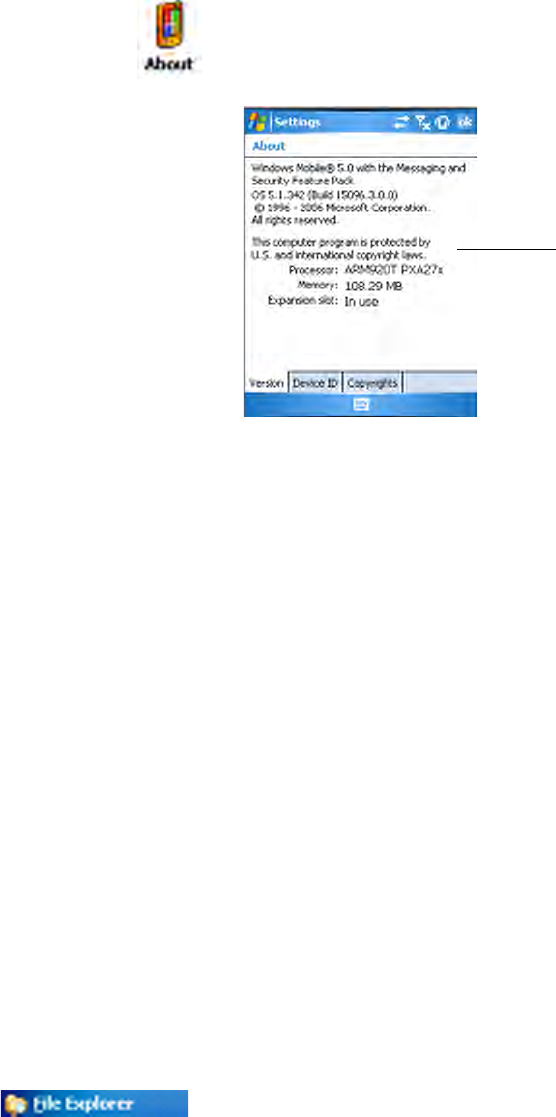
Chapter 2 — Windows Mobile
34 PRELIMINARY - CN3 Mobile Computer User’s Manual
Adding Programs Using ActiveSync
Install the appropriate software for your CN3 Computer on your desktop
before installing it on your CN3 Computer.
2Download the program to your desktop (or insert the CD or disk that
contains the program into your desktop). You may see a single *.XIP,
*.EXE, or *.ZIP file, a SETUP.EXE file, or several versions of files for
different CN3 Computer types and processors. Be sure to select the pro-
gram designed for the Windows Mobile and your CN3 Computer pro-
cessor type.
3Read any installation instructions, Read Me files, or documentation that
comes with the program. Many programs provide special installation
instructions.
4Connect your CN3 Computer and desktop.
5Double-click the *.EXE file.
• If the file is an installer, the installation wizard begins. Follow the
directions on the screen. Once the software is installed, the installer
automatically transfers the software to your CN3 Computer.
• If the file is not an installer, an error message stating that the program
is valid but it is designed for a different type of computer is displayed.
Move this file to your CN3 Computer. If you cannot find any instal-
lation instructions for the program in the Read Me file or documenta-
tion, use ActiveSync Explore to copy the program file to the Program
Files folder on your CN3 Computer. For more information on copy-
ing files using ActiveSync, see ActiveSync Help.
1Determine your CN3 Computer and processor type so that you know
which version of the software to install. Tap Start > Settings > the Sys-
tem tab > the About icon > the Version tab, then make a note of the
information in Processor.
Once installation is complete, tap Start > Programs, and then the program
icon to switch to it. For future use, this is added to your Start menu in the
Recent Programs area, via Start > File Explorer.
Note this information
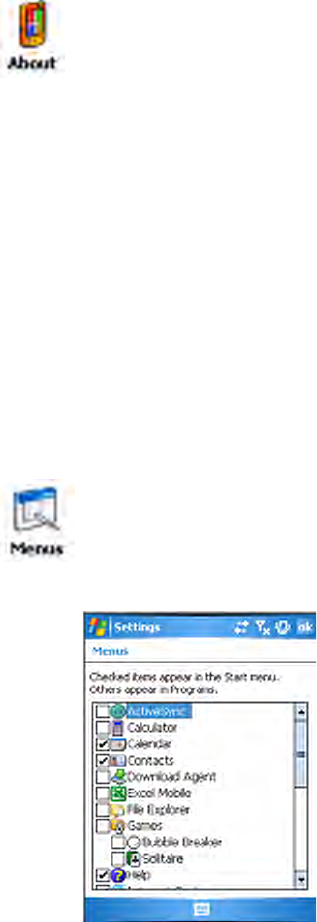
Chapter 2 — Windows Mobile
CN3 Mobile Computer User’s Manual - PRELIMINARY 35
Adding a Program Directly from the Internet
2Download the program to your CN3 Computer straight from the Inter-
net using Pocket Internet Explorer. You may see a single *.XIP, *.EXE,
or *.ZIP file, a SETUP.EXE file, or several versions of files for different
CN3 Computer types and processors. Be sure to select the program
designed for the Windows Mobile and your CN3 Computer processor
type.
3Read program installation instructions, Read Me files, or other docu-
mentation. Many programs provide installation instructions.
4Tap the file, such as a *.XIP or *.EXE file to start the installation wizard.
Follow the directions on the screen.
Adding a Program to the Start Menu
1Determine your CN3 Computer and processor type so that you know
which version of the software to install. Tap Start > Settings > the Sys-
tem tab > the About icon > the Version tab, then make a note of the
information in Processor.
Tap Start > Settings > the Personal tab > the Menus icon, then the check
box for the program. If you do not see the program listed, you can either
use File Explorer on the CN3 Computer to move the program to the Start
Menu folder, or use ActiveSync on the desktop to create a shortcut to the
program and place the shortcut in the Start Menu folder.

Chapter 2 — Windows Mobile
36 PRELIMINARY - CN3 Mobile Computer User’s Manual
Using File Explorer on the CN3 Computer
Using ActiveSync on the desktop
Removing Programs
Microsoft ActiveSync
Visit the following Microsoft Web site for the latest in updates, technical
information, and samples:
www.microsoft.com/windowsmobile/resources/communities/
default.mspx
Using Microsoft ActiveSync, you can synchronize the information on your
desktop with the information on your CN3 Computer. Synchronization
compares the data on your CN3 Computer with your desktop and updates
both computers with the most recent information. For example:
• Keep Pocket Outlook data up-to-date by synchronizing your CN3 Com-
puter with Microsoft Outlook data on your desktop.
• Synchronize Microsoft Word and Microsoft Excel files between your
CN3 Computer and desktop. Your files are automatically converted to
the correct format.
Tap Start > Programs > the File Explorer icon, locate the program (tap the
folder list, labeled My Documents by default, then My Device to see a list
of all folders on the CN3 Computer). Tap and hold the program and tap
Cut on the pop-up menu. Open the Start Menu folder located in the Win-
dows folder, tap and hold a blank area of the window, and tap Paste on the
pop-up menu. The program now appears on the Start menu. For more
information on using File Explorer, see “Finding and Organizing Informa-
tion” on page 32.
For future use, this is added to your Start menu in the Recent Programs
area, via Start > File Explorer.
Use the Explorer in ActiveSync to explore your CN3 Computer files and
locate the program. Right-click the program, and then click Create Short-
cut. Move the shortcut to the Start Menu folder in the Windows folder.
The shortcut now appears on the Start menu. For more information, see
ActiveSync Help.
Tap Start > Settings > the System tab > the Remove Programs icon. If
the program does not appear in the list of installed programs, use File
Explorer on your CN3 Computer to locate the program, tap and hold the
program, and then tap Delete on the pop-up menu.
Note: By default, ActiveSync does not automatically synchronize all types
of information. Use ActiveSync options to turn synchronization on or off
for specific information types.
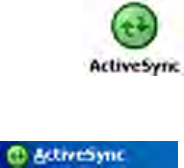
Chapter 2 — Windows Mobile
CN3 Mobile Computer User’s Manual - PRELIMINARY 37
With ActiveSync, you can also:
• Back up and restore your CN3 Computer data.
• Copy (rather than synchronize) files between your CN3 Computer and
desktop.
• Control when synchronization occurs by selecting a synchronization
mode. For example, you can synchronize continually while connected to
your desktop or only when you choose the synchronize command.
• Select which information types are synchronized and control how much
data is synchronized. For example, you can choose how many weeks of
past appointments you want synchronized.
Before you begin synchronization, install ActiveSync on your desktop from
the Windows Mobile Companion CD. For more information on installing
ActiveSync, see your Quick Start card. ActiveSync is already installed on
your CN3 Computer.
After installation is complete, the ActiveSync Setup Wizard helps you con-
nect your CN3 Computer to your desktop, set up a partnership so you can
synchronize information between your CN3 Computer and your desktop,
and customize your synchronization settings. Your first synchronization
process automatically begins when finished using the wizard.
After your first synchronization, look at Calendar, Contacts, and Tasks on
your CN3 Computer. Notice that information you have stored in
Microsoft Outlook on your desktop was copied to your CN3 Computer,
and you did not have to type a word. Disconnect the CN3 Computer from
your computer and you are ready to go!
Once you have set up ActiveSync and completed the first synchronization
process, you can initiate synchronization from your CN3 Computer. To
switch to ActiveSync on your CN3 Computer, tap Start > Programs > the
ActiveSync icon. Note that if you have a wireless LAN card, you can syn-
chronize remotely from your CN3 Computer.
For future use, this is added to your Start menu in the Recent Programs
area, via Start > ActiveSync.
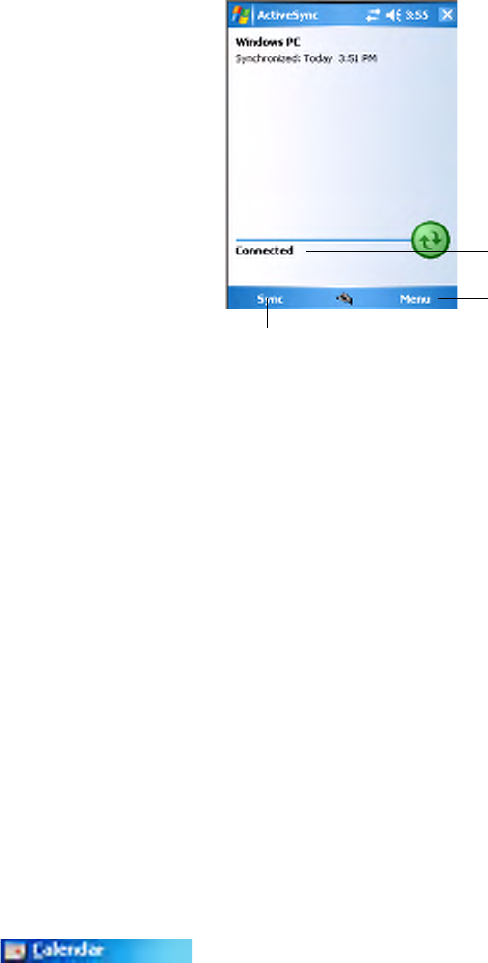
Chapter 2 — Windows Mobile
38 PRELIMINARY - CN3 Mobile Computer User’s Manual
For information about using ActiveSync on your desktop, start ActiveSync
on your desktop, and then see ActiveSync Help.
For more information about ActiveSync on your CN3 Computer, switch
to ActiveSync, tap Start > Help, then select a topic.
Microsoft Pocket Outlook
Microsoft Pocket Outlook includes Calendar, Contacts, Tasks, Messaging,
and Notes. You can use these programs individually or together. For exam-
ple, you can use e-mail addresses stored in Contacts to address e-mail mes-
sages in Messaging.
Using ActiveSync, you can synchronize information in Microsoft Outlook
or Microsoft Exchange on your desktop with your CN3 Computer. You
can also synchronize this information directly with a Microsoft Exchange
server. Each time you synchronize, ActiveSync compares the changes you
made on your CN3 Computer and desktop or server and updates both
computers with the latest information. For information on using Active-
Sync, see ActiveSync Help on the desktop.
You can switch to any program by tapping it on the Start menu.
Calendar: Scheduling Appointments and Meetings
Use Calendar to schedule appointments, including meetings and other
events. You can check your appointments in one of several views (Day,
Week, Month, Year, and Agenda) and set Calendar to remind you of
appointments with a sound or other method.
Appointments for the day can display on the Today screen.
To switch to Calendar on the CN3 Computer, tap Start > Calendar.
View the connection status
Tap to connect and synchronize
Tap to synchronize via IR or to change synchronization
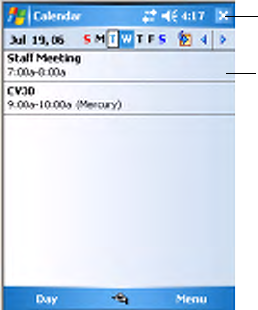
Chapter 2 — Windows Mobile
CN3 Mobile Computer User’s Manual - PRELIMINARY 39
If you use Outlook on your desktop, you can synchronize appointments
between your CN3 Computer and desktop.
Synchronizing Calendar
Calendar items stored on your CN3 Computer can be synchronized with
calendar items on your desktop or Microsoft Exchange Server. (Note that
you can only synchronize information directly with an Exchange Server if
your company is running Microsoft Mobile Information Server 2002 or
later.) Calendar synchronization is automatically selected in ActiveSync.
Calendar items entered on one computer are copied to the other during
synchronization. Handwritten notes and drawings are saved as metafiles
(pictures).
For information on synchronization, see ActiveSync Help on the desktop.
Why Use Categories in the Calendar?
Use categories to group related tasks, contacts, and appointments. Then,
use these groupings to quickly display only the information you want. For
example, you can easily share your CN3 Computer with another by assign-
ing your appointments to a category with a special project’s name. You can
then use this category to filter Calendar and only display appointments for
that project.
Tap to go to Today
Tap to display and edit appointment details
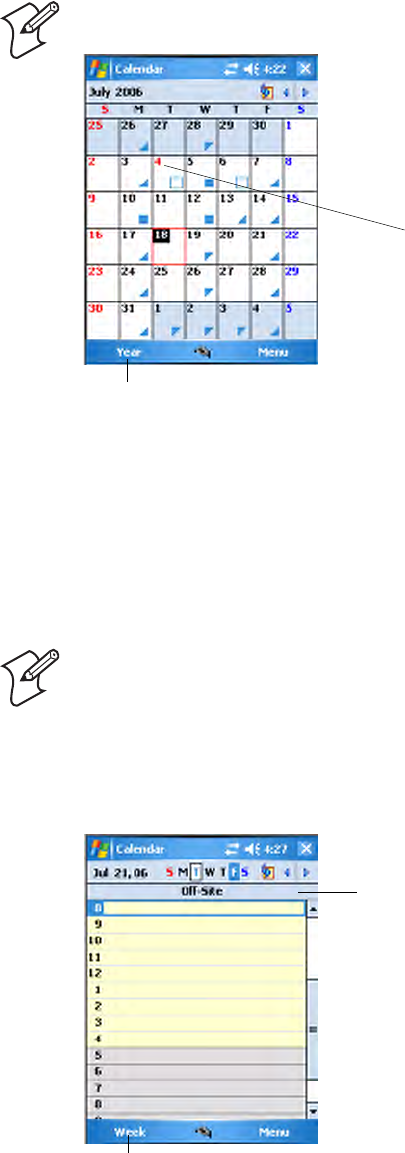
Chapter 2 — Windows Mobile
40 PRELIMINARY - CN3 Mobile Computer User’s Manual
What’s an All Day Event?
An appointment can either be a normal appointment or an all day event,
which lasts the full day or spans many days. Examples include a trade show,
a vacation, or a seminar. You can also use all day events to schedule an
annual event, such as a birthday or anniversary. In this case, change the Sta-
tus box to Free (you may need to scroll to see it) so that it does not show
time as busy in your calendar. All day events do not occupy blocks of time
in Calendar; they appear in banners at the top of the calendar.
Note: In Month View, the day of an appointment assigned to the Holiday
category appears in red.
Note: You cannot modify or create all-day events with attendees on the
CN3 Computer. If you create all day events with attendees on your desk-
top, use ActiveSync to copy such events to the CN3 Computer, then view
them in Calendar. For more information on copying files, see ActiveSync
Help. To use the CN3 Computer to schedule an appointment with attend-
ees lasting all day, set type to “Normal,” then adjust the date and time
appropriately.
This day was assigned the Holiday category.
Tap to access the Year view
This describes the all-day event
Tap to access the Week view

Chapter 2 — Windows Mobile
CN3 Mobile Computer User’s Manual - PRELIMINARY 41
What’s a Recurrence Pattern?
If you have an appointment or task that you do on a regular basis, such as a
weekly team meeting or a monthly status report, enter the item once and
set a recurrence pattern for it. If the default patterns in the list are not what
you need, you can create your own pattern using the wizard.
Viewing Appointments
You can view appointments in one of several views (Agenda, Day, Week,
Month, and Year). In Agenda view, upcoming appointments are displayed
in bold. To see detailed appointment information in any view, tap the
appointment. To see a list of available actions for an appointment, tap and
hold the appointment. Tap Start > Toda y to see appointments for the day.
Month view displays symbols to indicate the types of appointments you
have on a given day. An upward triangle indicates a morning appointment;
a downward triangle indicates an afternoon appointment. If you have
appointments in the morning and afternoon, a solid square is displayed. If
you have an all day event not marked Free, a hollow square is displayed.
Select your recurrence pattern from this list
Select <edit pattern> to access the wizard with which
to customize your recurrence.
Tap this to access the Year view
This displays a morning appointment
This displays an afternoon appointment
This displays appointments in morning and afternoon
This displays an all-day event not marked “Free”
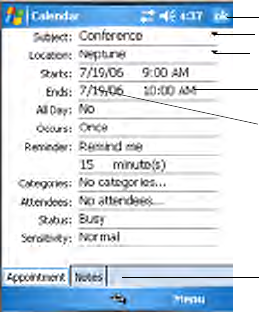
Chapter 2 — Windows Mobile
42 PRELIMINARY - CN3 Mobile Computer User’s Manual
Creating or Changing an Appointment
To create an appointment, tap Menu > New Appointment. To select a
new date from a pop-up calendar, tap the display date. To enter or select a
new time, tap the display time. Enter the appointment details, and when
finished, tap ok to return to the calendar.
If you are working in Day view, tap and hold the time slot for the new
appointment, then select New Appointment to have the time automatically
entered for you.
To change an appointment, tap it in the calendar, and then tap Edit.
Change any appointment detail by tapping it and entering the new infor-
mation. Tap the arrows to the right of the description and location boxes to
choose from previous entries.
When entering a time, you can type military and abbreviated time forms,
such as 2300 (becomes 11:00 PM), 913pm (becomes 9:13 PM), 911
(becomes 9:11 AM), and 9p (becomes 9:00 PM).
Creating an All-Day Event
To create an all-day event, do the following. To change an all-day event,
switch to Day or Agenda, tap the event listed at the top of the calendar,
then tap Edit. Change any appointment detail by tapping it and entering
the new information.
1Tap Menu > New Appointment.
2Tap All Day, then select Yes.
Tap to return to calendar, saved automatically
Tap to choose from predefined text
Tap to choose from previous defined locations
Tap to select a time
Tap to select a date
Notes is a good place for maps and directions

Chapter 2 — Windows Mobile
CN3 Mobile Computer User’s Manual - PRELIMINARY 43
You cannot modify or create all day events with attendees on the CN3
Computer. If you create all-day events with attendees on your desktop, use
ActiveSync to copy such events to the CN3 Computer. Then, view them in
Calendar. For more information on copying files, see ActiveSync Help. To
use the CN3 Computer to schedule an appointment with attendees lasting
all day, set type to Normal, then adjust date and time accordingly.
Setting a Reminder for an Appointment
Do the following to set a reminder for an appointment in the calendar:
1Tap the appointment, then tap Edit to change the appointment.
2Tap Reminder and select Remind me.
3To change how many minutes before the appointment you are
reminded, tap the minutes displayed, then select the new minutes from a
drop-down or enter the new minutes. Tap minutes to change hours,
days, or weeks.
Tap to select “Yes” or “No” for the all-day event
Tap this to enable the reminder feature
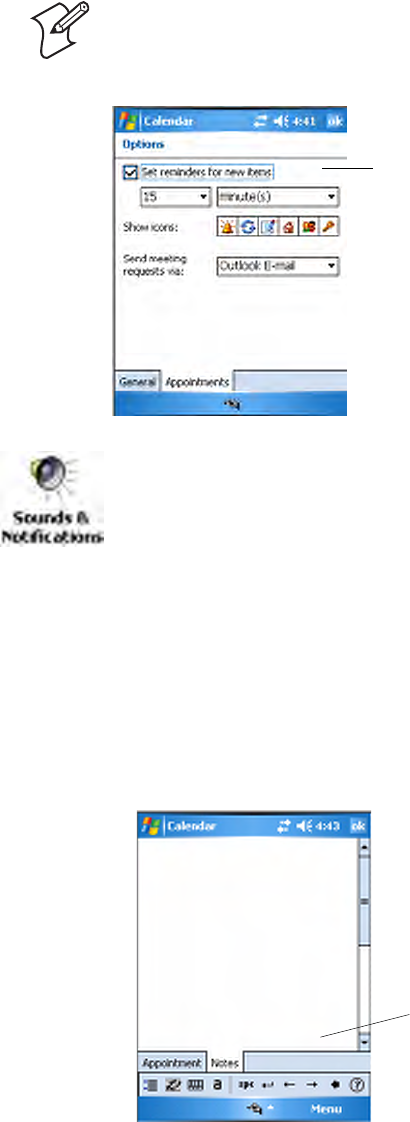
Chapter 2 — Windows Mobile
44 PRELIMINARY - CN3 Mobile Computer User’s Manual
Adding a Note to an Appointment
You can add written or typed notes and even recordings (if your CN3
Computer supports recordings) to an appointment. This is a good place for
maps, drawings, and other detailed information. To edit an existing note, tap
the appointment in the calendar, tap Edit, then tap the Notes tab.
1In the calendar, tap the appointment, then tap Edit.
2Tap the Notes tab to enter notes. For specific instructions, tap Start >
Help, then select a topic.
Note: To automatically set a reminder for all new appointments, in the cal-
endar, tap Menu > Options > the Appointments tab, check Set reminders
for new items, then tap the number and timeframe options to change the
information given.
To choose how you are reminded, for example by a sound, tap Start > Set-
tings > the Personal tab > the Sounds & Notifications icon.
Tap this to set reminders for new appointments
Use your stylus to write or draw information here

Chapter 2 — Windows Mobile
CN3 Mobile Computer User’s Manual - PRELIMINARY 45
Making an Appointment Recurring
Do the following to make a recurring appointment:
1In the calendar, tap the appointment, then tap Edit.
2Tap Occurs and select a pattern from the list. Or, to create a new pat-
tern, tap <Edit pattern...>, and follow the steps in the wizard.
Assigning an Appointment to a Category
To find an appointment assigned to a category, tap Menu > Filter, then
select the type of appointment that you want displayed. To show all
appointments again, tap Menu > Filter > All Appointments to clear all cat-
egories.
1In the calendar, tap the appointment, tap Edit, then tap Categories.
2Check the categories to which you want to assign the appointment.
3To create a new category, tap New, enter the category name, then tap
Done. The new category is automatically checked in the list.
4Tap ok to return to the appointment.
Select your recurrence from the drop-down list
Select <edit pattern> to customize your recurrence
A check mark indicates a selected category
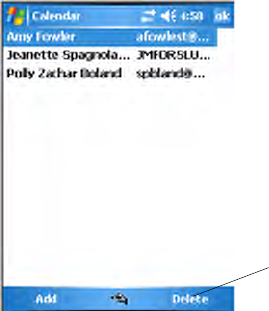
Chapter 2 — Windows Mobile
46 PRELIMINARY - CN3 Mobile Computer User’s Manual
Sending a Meeting Request
Use Calendar to schedule meetings with people who use Outlook or Pocket
Outlook. When attendees receive a meeting request, they can accept or
decline the meeting. If they accept the request, the meeting is automatically
added to their schedule, their response is sent back to you, and your calen-
dar is updated.
Before you can send a meeting request, you must enter e-mail addresses in
Contacts Help and set up Messaging to send and receive messages. For
more information on sending and receiving meeting requests, open either
the Calendar application or the Messaging application, tap Start > Help,
then select a topic.
If you are sending the meeting request through a connection to an ISP or
the network, rather than through synchronization with your desktop, tap
Menu > Options > the Appointments tab. From the Send meeting request
via drop-down list, tap the service to use to send the request.
1Tap to hold a timeslot in the calendar, then tap New Appointment.
2Enter the meeting information, hide the onscreen keyboard, if needed,
then tap Attendees. Only those contacts with e-mail addresses are dis-
played. Select the contacts you want to invite, then tap Add to return to
the list.
3Repeat this procedure until you have everyone you want to invite to the
meeting, then tap ok.
4Messaging automatically creates a meeting request and sends it to the
attendees the next time you synchronize with your desktop. Textual
notes entered in the Notes tab (excluding writing) are also sent.
To remove a person, highlight that person,
then tap Delete
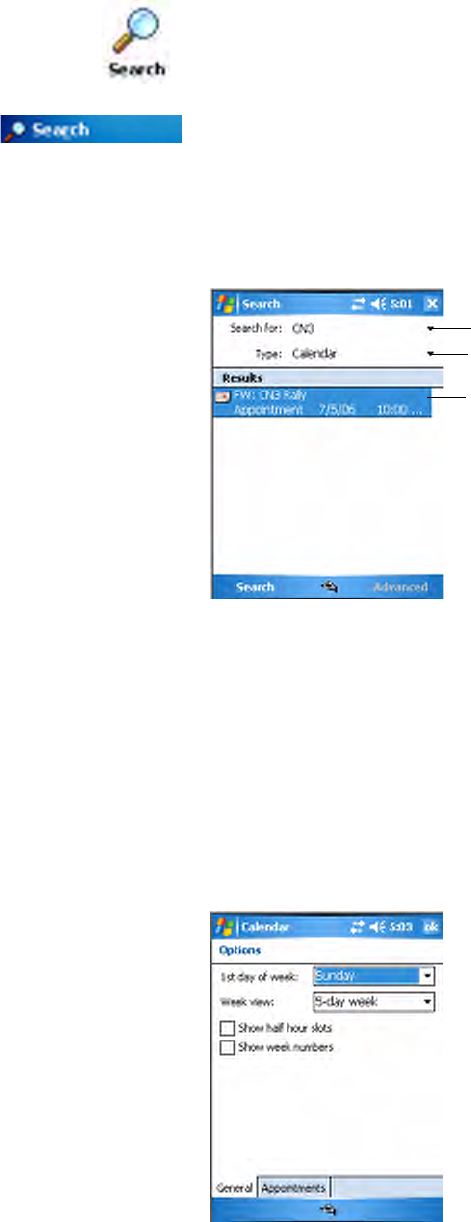
Chapter 2 — Windows Mobile
CN3 Mobile Computer User’s Manual - PRELIMINARY 47
Finding an Appointment
• To find an appointment assigned to a category, tap Menu > Filter, then
select the type of appointment that you want displayed. To show all
appointments again, tap Menu > Filter > All Appointments to clear all
categories.
Deleting an Appointment
1In the calendar, tap and hold the appointment.
2On the pop-up menu, tap Delete Appointment. The next time you syn-
chronize, the appointment is also deleted from the desktop.
Changing Calendar Options
In the calendar, tap Menu > Options, tap either tap, make your changes,
then tap ok to return to the calendar.
•Tap the General tab to change the calendar view.
•Tap Start > Programs > the Search icon, enter the appointment name,
tap the Type arrow and select “Calendar” from the drop-down list, and
then tap Search. You can tap the Search for drop-down arrow to select
from a list of previously searched items or phrases.
Note for future access, this is added to your Start menu in the Recent
Programs area, via Start > Search.
Tap to select or enter a phrase
Tap to select where to search for this phrase
Tap to see details
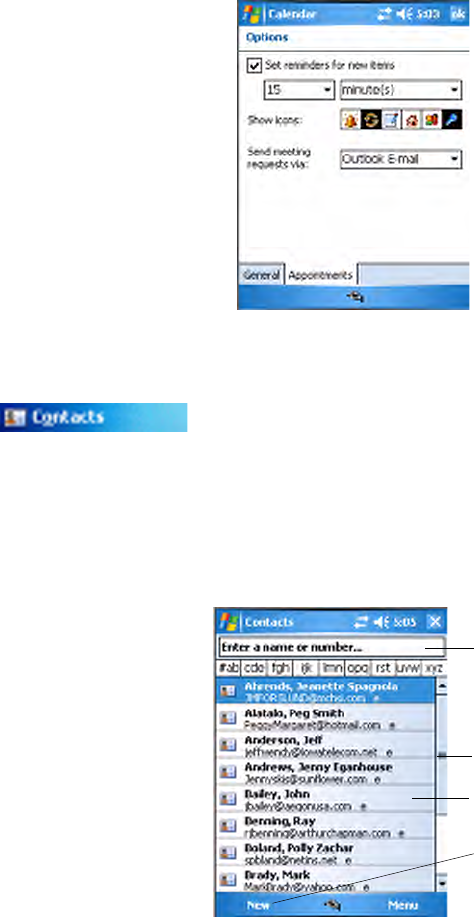
Chapter 2 — Windows Mobile
48 PRELIMINARY - CN3 Mobile Computer User’s Manual
•Tap the Appointments tab to select what Show icons appointment indi-
cators should appear when you view appointment contents. Tap and
hold an icon to see its name. Selected icons are in black.
Contacts: Tracking Friends and Colleagues
Contacts maintains a list of your friends and colleagues so that you can eas-
ily find the information you are looking for, whether you are at home or on
the road. You can enter both personal and business information.
If you use Microsoft Outlook on your desktop, you can synchronize con-
tacts between your CN3 Computer and your desktop.
Creating a Contact
1Tap New, then use the input panel to enter a name and other contact
information. Scroll down to see all available fields.
2To assign the contact to a category, scroll to and tap Categories, then
select a category from the list. In the contact list, you can display contacts
by category.
To switch to Contacts on the CN3 Computer, tap Start > Contacts.
Tap and enter part of a name to find it in the list
Tap to see additional phone numbers, e-mail addresses
Tap to display and edit contact details
Tap to create a new contact
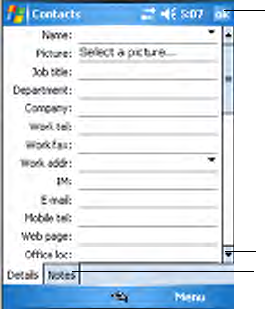
Chapter 2 — Windows Mobile
CN3 Mobile Computer User’s Manual - PRELIMINARY 49
3To add notes, tap the Notes tab. You can enter text or draw. For infor-
mation on creating notes, see “Notes: Capturing Thoughts and Ideas”
on page 54.
4When finished, tap ok to return to the contact list.
Synchronizing Contacts
Contacts stored on your CN3 Computer can be synchronized with Out-
look contacts stored on your desktop or with Mobile Information Server
2002 or later.
New items entered in one location are copied to the other during synchro-
nization. Handwritten notes and drawings are saved as pictures when syn-
chronizing with your desktop, but are removed when synchronizing with a
server.
For information on synchronization, see ActiveSync Help on the desktop.
Viewing Contacts
The contact list displays the contact name and the first primary phone
number or e-mail address specified for that contact. Contacts are ordered
by name of contact or company. You can change the appearance of the Con-
tacts list by tapping Menu > Options.
• Tap the default letter (home, w ork, mobile, or e-mail) to the right of the
contact to see additional phone numbers and e-mail addresses.
• Use the up/down controls on your keypad to highlight a contact, then
press the left/right controls on your keypad to change the default num-
ber, displayed as a letter to the right of the contact name. The default
number is highlighted in the contact’s summary, like the sample below.
• To see more contact information, tap the contact.
• To see a list of available actions for a contact via a pop-up menu, tap and
hold the contact.
Tap to return to the list, entry saved automatically
Scroll to see more fields
Use Notes to include maps and directions
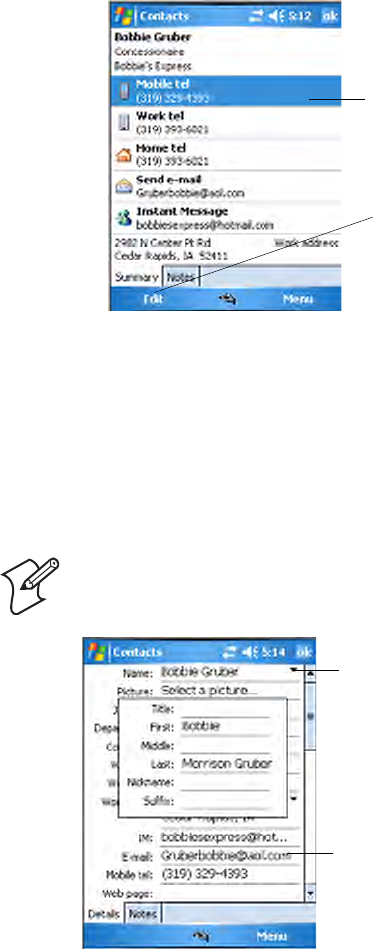
Chapter 2 — Windows Mobile
50 PRELIMINARY - CN3 Mobile Computer User’s Manual
• To see a list of contacts employed by a specific company, tap Menu >
View By > Company. Then, tap the desired company name.
Creating or Changing a Contact
• To create a contact, tap New. To enter notes, tap the Notes tab. When
finished, tap ok to return to the contact list. New contacts are added to the
displayed category.
• To change a contact, tap it in the contact list, and then tap Menu > Edit.
To cancel edits, tap Menu > Undo. When finished making changes, tap
ok to return to the contact list.
Adding a Note to a Contact
You can add written or typed notes and even recordings (if your CN3
Computer supports recordings) to a contact. Notes are handy for maps and
drawings. To edit an existing note, tap the contact, tap Menu > Edit, then tap
the Notes tab.
1In the contact list, tap the contact.
Note: If you enter a name with more than two words, the middle word is
recorded as a middle name. If your contact has a double first or last name,
tap the Name arrow and enter the names in the proper box.
Indicates the default number
Tap to edit the default number
Tap to access the Name fields
Tap outside the box to close and return to details

Chapter 2 — Windows Mobile
CN3 Mobile Computer User’s Manual - PRELIMINARY 51
2Tap the Notes tab. For instructions, tap Start > Help, then select a topic.
Assigning a Contact to a Category
1In the contact list, tap the contact, and then tap Menu > Edit.
2Scroll to, tap Categories, then check categories to assign to the contact.
3To create a new category, tap New, enter the category name, then tap
Done. The new category is automatically checked in the list.
4Tap ok to return to the contacts.
Copying a Contact
Press and hold a contact for a pop-up menu, then select Copy Contact; or
if a contact is already highlighted, tap Menu > Copy Contact.
Sending a Message to a Contact
Press and hold a contact for a pop-up menu, then select Send E-mail or
Send SMS depending on the type of message being sent. To send an e-mail
message, you must have an e-mail address configured for the contact. To
send an SMS (Short Messaging Service) message, you must have an SMS
number for the contact, which is usually the mobile phone number.
Use your stylus to write or draw your information
Tap to activate the input panel
A check mark indicates a selected category
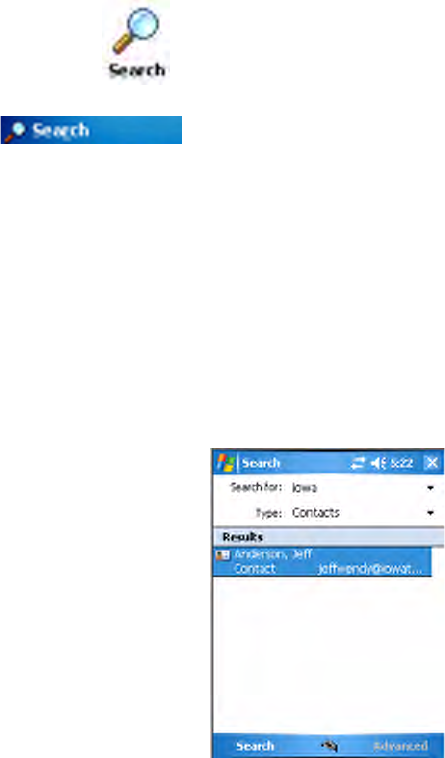
Chapter 2 — Windows Mobile
52 PRELIMINARY - CN3 Mobile Computer User’s Manual
Finding a Contact
Use any of the following methods to find a contact. To quickly move
through a long list of contacts, tap one of the sets of letters displayed at the
top to view contact names beginning with those letters.
• From Contacts, start typing a contact name until you see it displayed on
the screen. To show all contacts again, tap the text box at the top of the
screen and clear the text, or tap the arrow to the right of the text box.
• To find a contact assigned to a category, tap Menu > Filter, then select
the type of contact to display. To show all contacts again, tap Menu >
Filter > All Contacts to clear all categories.
• To view the names of companies for which your contacts work, in the
contact list, tap Menu > View By > Company. The number of contacts
that work for that company is displayed to the right of the company.
Deleting a Contact
Press and hold a contact for a pop-up menu, select Delete Contact, then
select Yes; or if a contact is already highlighted, tap Menu > Delete Con-
tact, then select Yes.
•Tap Start > Programs > the Search icon, enter the contact name, tap the
Type arrow and select “Contacts” from the drop-down list, and then tap
Search. You can tap the Search for drop-down arrow to select from a list of
previously searched items or phrases.
Note for future access, this is added to your Start menu in the Recent
Programs area, via Start > Search.
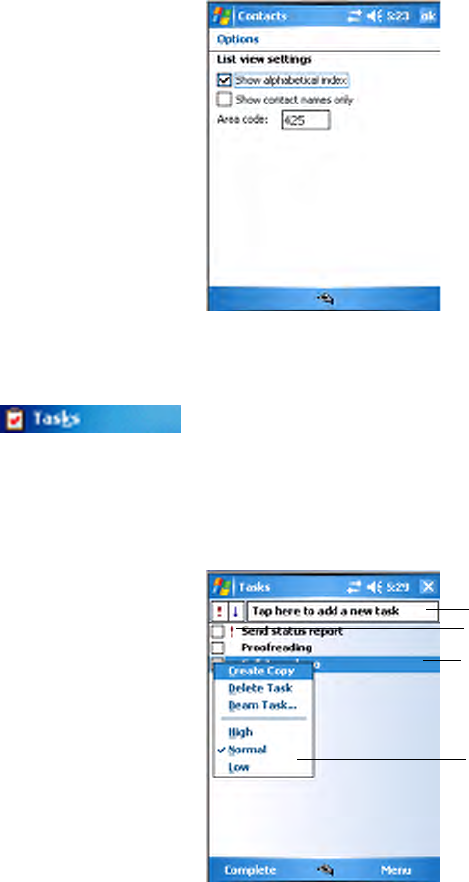
Chapter 2 — Windows Mobile
CN3 Mobile Computer User’s Manual - PRELIMINARY 53
Changing Contacts Options
In the contact list, tap Menu > Options, make your changes, then click ok
to return to the Contacts list.
Tasks: Keeping a To Do List
Use Tasks to keep track of what you have to do. A variety of task informa-
tion can display on the Today screen. If you use Microsoft Outlook on
your desktop, you can synchronize tasks between your CN3 Computer and
desktop. To change the way information is displayed, tap Menu > Options.
Creating a Task
To quickly create a task with only a subject, tap Tap here to add a new task
and enter your task information.
• To quickly create a task, enter text in the Tap here to add a new task box
at the top of the screen. If you do not see this box, tap Menu > Options,
then check Show Tasks entry bar.
• To create a task with detailed information, such as start and due dates,
tap New. To enter notes, tap the Notes tab. You can enter a start date
and due date or enter other information by first tapping the field. If the
input panel is open, you need to hide it to see all available fields. You can
To switch to Tasks on your CN3 Computer, tap Start > Tas ks.
Use this to assign a task quickly
Indicates a high priority
Tap to display or edit details
Tap and hold to display a pop-up menu
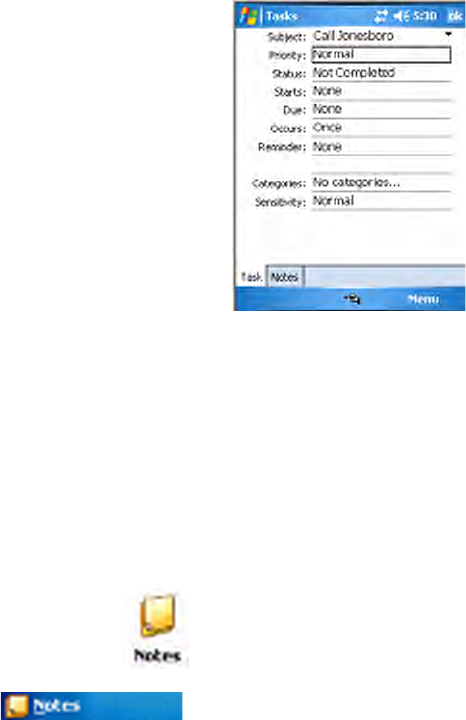
Chapter 2 — Windows Mobile
54 PRELIMINARY - CN3 Mobile Computer User’s Manual
enter text or draw. For information on creating notes, see “Notes: Cap-
turing Thoughts and Ideas” on page 54.
• To change a task, tap it in the task list, and then tap Edit. Using the
onscreen keyboard, enter a description. To assign the task to a category,
tap Categories and check categories from the list. In the task list, you can
filter tasks by category. When finished, tap ok to return to the task list.
Synchronizing Tasks
Tasks stored on the CN3 Computer can synchronize with Microsoft Out-
look on your desktop. Task synchronization is automatic in ActiveSync.
New items entered on one computer are copied to the other during syn-
chronization. Handwritten notes and drawings are saved as metafiles (pic-
tures). For information, see ActiveSync Help on the desktop.
Notes: Capturing Thoughts and Ideas
Notes helps you quickly capture your ideas, notes, and thoughts. You can
create a note using written and typed text, drawings, and recordings. You
can also share your notes with others through e-mail, infrared, and synchro-
nization with your desktop.
To create documents with advanced formatting or templates, such as bul-
leted lists and tabs, use word processing software developed for your CN3
Computer, such as Word Mobile.
To switch to Notes on your CN3 Computer, tap Start > Programs > the
Notes icon.
Note for future access, this is added to your Start menu in the Recent Pro-
grams area, via Start > Notes.
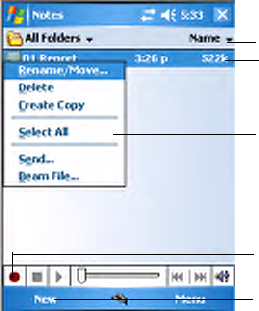
Chapter 2 — Windows Mobile
CN3 Mobile Computer User’s Manual - PRELIMINARY 55
Creating a Note
To create your note, tap New, then write, draw, type, or record your infor-
mation. For information about using the input panel, writing and drawing,
and creating recordings, see “Basic Usage” on page 22.
•Writing
Using the stylus, write directly on the screen.
•Drawing
Using the stylus, draw directly on the screen.
•Typing
Using the input panel, enter typed text into the CN3 Computer. Do this
by tapping keys on the onscreen keyboard or by using handwriting rec-
ognition software.
•Recording
Create a stand-alone recording or embed a recording into a note.
Synchronizing Notes
Notes can synchronize between your desktop and CN3 Computer either
through notes synchronization or file synchronization. Notes synchroniza-
tion synchronizes the notes on your CN3 Computer with Outlook Notes
on your desktop. File synchronization synchronizes all notes on the CN3
Computer with the My Documents folder for the CN3 Computer on your
desktop.
To synchronize your notes through notes synchronization, first select the
Notes information type for synchronization in ActiveSync. The next time
you synchronize, all notes in My Documents and its subfolder on your
CN3 Computer appear in Outlook Notes on your desktop. Notes that
contain only text appear as regular notes in Outlook on your desktop, while
notes containing written text or drawings appear in the device format. In
addition, all notes in the Notes group in Outlook on the desktop appear in
Notes on the CN3 Computer.
To synchronize your notes as files, in ActiveSync, select the Files informa-
tion type for synchronization and clear the Notes information type. When
you select Files, the My Documents folder for the CN3 Computer is cre-
Tap to change the sort order of the list
Tap to open a note or play a recording
Tap and hold to display a pop-up menu
Tap to record
Tap to create a new note
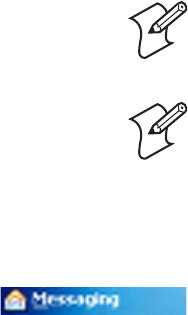
Chapter 2 — Windows Mobile
56 PRELIMINARY - CN3 Mobile Computer User’s Manual
ated on your desktop. All .PWI files placed in the My Documents folder on
your CN3 Computer and all .DOC files placed in the My Documents
folder for the CN3 Computer on your desktop are synchronized. Password-
protected files cannot be synchronized.
ActiveSync converts documents during synchronization. For information
on synchronization or file conversion, see ActiveSync Help on the desktop.
Messaging: Sending and Receiving E-mail Messages
You can receive Internet e-mail messages and SMS messages in Messaging.
Internet e-mail messages are sent by using an address you receive from your
Internet service provider (ISP) or your employer. SMS messages are sent
and received through your wireless phone service provider by using a phone
number as the message address.
You can send and receive e-mail by synchronizing with your desktop, or by
connecting to a Post Office Protocol 3 (POP3) or Internet Message Access
Protocol 4 (IMAP4) mail server. You need to set up an e-mail account for
each method that you use except for Microsoft ActiveSync, which is set up
by default. The ActiveSync folder on your CN3 Computer stores messages
that you send and receive through synchronization with a desktop. Account
names appear as folders in the folder list (located on the left, under the nav-
igation bar) in the Messaging message list.
With synchronization, messages are synchronized between the CN3 Com-
puter Inbox and the PC Inbox by using ActiveSync and Microsoft
Exchange or Microsoft Outlook. For more information, see “Synchroniz-
ing E-mail Messages” on the next page.
When connecting to a POP3 or IMAP4 server, you use a modem to con-
nect to your Internet service provider (ISP) or a modem card to connect to
the local area network to which your e-mail server is connected. You can
also use your phone to connect by using a cellular line connection. For
more information, see “Connecting to a Mail Server” on page 58.
Synchronizing E-mail Messages
After selecting Messaging for synchronization in ActiveSync, e-mail mes-
sages are synchronized as part of the general synchronization process. Dur-
ing synchronization:
Note: When you delete or change an item on either your desktop or the
CN3 Computer, the item is changed or deleted in the other location the
next time you synchronize.
Note: If you synchronize your notes using file synchronization and then
later decide to use notes synchronization, all of your notes are synchronized
with Outlook on your desktop and no longer store in the My Documents
folder for the CN3 Computer.
To switch to Messaging on your CN3 Computer, tap Start > Messaging.
Chapter 2 — Windows Mobile
CN3 Mobile Computer User’s Manual - PRELIMINARY 57
• Messages are copied from the Inbox folder on your desktop or the
Microsoft Exchange server to the Inbox folder on your CN3 Computer.
(Note that you can only synchronize information directly with an
Exchange Server if your company is running Microsoft Mobile Informa-
tion Server 2002 or later.) By default, you receive messages from the last
three days only, the first 100 lines of each new message, and file attach-
ments of less than 100 KB in size.
• Messages in the Outbox folder on your CN3 Computer are transferred
to Exchange or Outlook and then sent from those programs.
• The messages on the two computers are linked. When you delete a mes-
sage on your CN3 Computer, it is deleted from your desktop the next
time you synchronize.
• Messages in subfolders in other e-mail folders in Outlook are synchro-
nized only if they were selected for synchronization in ActiveSync.
For information on initiating Messaging synchronization or changing syn-
chronization settings, see ActiveSync Help on your desktop or tap Start >
Help, then select a topic.
Managing E-mail Messages and Folders
Each e-mail account and SMS account has its own folder hierarchy with
five default folders: Inbox, Outbox, Deleted Items, Drafts, and Sent Items.
The messages you receive and send through the mail account are stored in
these folders. You can also create additional folders within each hierarchy.
The Deleted Items folder contains messages that were deleted on the CN3
Computer. The behavior of the Deleted Items and Sent Items folders
depends on the Inbox options you have chosen.
The behavior of the folders you create depends on whether you are using
ActiveSync, SMS, POP3, or IMAP4.
•If you use ActiveSync, e-mail messages in the Inbox folder in Outlook
automatically synchronize with your CN3 Computer. You can select to
synchronize additional folders by designating them for ActiveSync. The
folders you create and the messages you move are then mirrored on the
server. For example, if you move two messages from the Inbox folder to a
folder named Family, and you have designated Family for synchroniza-
tion, the server creates a copy of the Family folder and copies the mes-
sages into that folder. You can then read messages while away from your
desktop.
•If you use SMS, messages are stored in the Inbox folder.
•If you use POP3 and you move e-mail messages to a folder you created,
the link is broken between the messages on the CN3 Computer and their
copies on the mail server. The next time you connect, the mail server sees
that the messages are missing from the CN3 Computer Inbox and
deletes them from the server. This prevents you from having duplicate
copies of a message, but it also means that you no longer have access to
Chapter 2 — Windows Mobile
58 PRELIMINARY - CN3 Mobile Computer User’s Manual
messages that you move to folders created from anywhere except the
CN3 Computer.
•If you use IMAP4, the folders you create and the e-mail messages you
move are mirrored on the server. Therefore, messages are available to you
anytime you connect to your mail server, whether it is from your CN3
Computer or desktop. This synchronization of folders occurs whenever
you connect to your mail server, create new folders, or rename/delete
folders when connected.
For all accounts except ActiveSync, you can access folder options by tap-
ping Menu > To o l s > Manage Folders.
Connecting to a Mail Server
In addition to synchronizing e-mail messages with your desktop, you can
send and receive e-mail messages by connecting to an e-mail server using a
modem or network card connected to your CN3 Computer. You need to
set up a remote connection to a network or an ISP, and a connection to
your e-mail server. For more information, see “Remote Access (Modems)”
on page 118.
When you connect to the e-mail server, new messages are downloaded to
the CN3 Computer Inbox folder, messages in the CN3 Computer Outbox
folder are sent, and messages that were deleted on the e-mail server are
removed from the CN3 Computer Inbox folder.
Messages that you receive directly from an e-mail server are linked to your
e-mail server rather than your desktop. When you delete a message on your
CN3 Computer, it is also deleted from the e-mail server the next time you
connect based on the settings selected in ActiveSync.
You can work online or offline. When working online, you read and
respond to messages while connected to the e-mail server. Messages are sent
as soon as you tap Send, which saves space on your CN3 Computer.
When working offline, once you have downloaded new message headers or
partial messages, you can disconnect from the e-mail server and then decide
which messages to download completely. The next time you connect,
Inbox downloads the complete messages you have marked for retrieval and
sends the messages you have composed.
Setting Up or Changing an Account
To set up a a POP3 or IMAP4 e-mail account, tap Menu > To o l s >
Options > New Account. Follow instructions in the New Account Wizard.
To set up an SMS account, tap Menu > Switch Accounts, and then tap
SMS. Follow the instructions on the screen.
To change options for an account, tap Menu > To o l s > Options > the
name of the account, and follow the instructions on the screen.

Chapter 2 — Windows Mobile
CN3 Mobile Computer User’s Manual - PRELIMINARY 59
To delete an account, tap Menu > To o l s > Options, tap and hold the name
of the account, and then tap Delete.
Downloading Messages from the Server
Note that receiving entire messages consumes storage memory. The size
column in the message list displays the local size and server size of a mes-
sage. Even when a message has downloaded fully, these numbers may differ
because the size of a message can vary between the server and the CN3
Computer.
1Tap Menu > Switch Accounts and ensure that the account you want to
use is selected (marked by a bullet.)
2The messages on your CN3 Computer and e-mail server are synchro-
nized: new messages are downloaded to the CN3 Inbox folder, messages
in the CN3 Outbox folder are sent, and messages that were deleted from
the server are removed from the CN3 Inbox. Tap a message in the mes-
sage list to open it.
3If you read a message and decide that you need the full copy, tap Menu >
Download Message while in the message window. If you are in the mes-
sage list, tap and hold the message, and then tap Download Message.
This also downloads message attachments if you selected those options
when you set up the e-mail account. You can also choose to download
full copies of messages by default.
4When finished, close Messaging.
Composing and Sending Messages
To compose a message, do the following.
If you are sending an SMS message and want to know if it was received,
before sending the message, tap Menu > Message Options > Request SMS
text message delivery notification.
Depending on the e-mail address options that you select, you can use a
directory service in addition to your contact list to verify names.
1In the message list, tap New.
2To select an account, tap the From list and select “ActiveSync,” “SMS,”
or the desired e-mail account.
3Enter the e-mail address or SMS address of one or more recipients, sepa-
rating them with semicolons. To access addresses and phone numbers
from Contacts, tap To.
4Enter your message. To quickly add common messages, tap Menu > My
Text, select a desired message.
5To check spelling, tap Edit > Spell Check.
Note: You can set up several e-mail accounts including your ActiveSync
account, but you can set up only one SMS account, which you cannot
delete once it is set up.
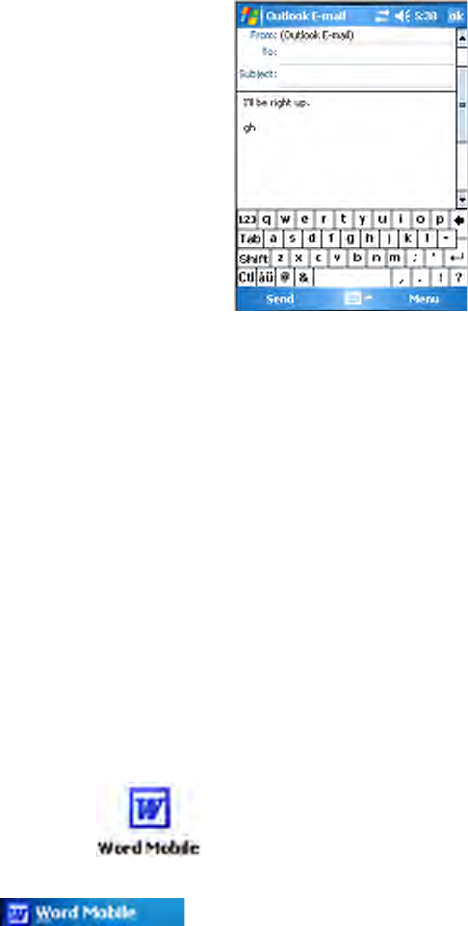
Chapter 2 — Windows Mobile
60 PRELIMINARY - CN3 Mobile Computer User’s Manual
6Tap Send. If you are working offline, the message is moved to the Out-
box folder and is sent the next time you connect.
Companion Programs
The companion programs consist of Word Mobile, Excel Mobile, and
PowerPoint Mobile, and Windows Media Player. To switch to a compan-
ion program on your CN3 Computer, tap Start > Programs, then tap the
program name.
Word Mobile
Word Mobile works with Microsoft Word on your desktop to give you
access to copies of your documents. You can create new documents on your
CN3 Computer, or you can copy documents from your desktop to your
CN3 Computer. Synchronize documents between your desktop and your
CN3 Computer to have up-to-date content in both locations.
Creating a Document
You can open only one document at a time; when you open a second docu-
ment, you have to save the first. You can save a document you create or edit
in formats such as Word (.DOC), Pocket Word (.PSW), Rich Text Format
(.RTF), and Plain Text (.TXT).
Word Mobile contains a list of files stored on your CN3 Computer. Tap a
file in the list to open it. To delete, make copies of, and send files, tap and
hold a file in the list, then, select the action on the pop-up menu.
Use Word Mobile to create documents, such as letters or meeting minutes.
To create a new file, tap Start > Programs > the Word Mobile icon > New.
You get either a blank document or a template, depending on what you
have selected under Menu > Tools > Options.
For future use, this is added to your Start menu in the Recent Programs
area, via Start > Word Mobile.

Chapter 2 — Windows Mobile
CN3 Mobile Computer User’s Manual - PRELIMINARY 61
You can enter information in Word Mobile in by typing or writing. Each
mode has its own toolbar, which you can show and hide by tapping the
Input Panel icon in the center of the command bar.
You can change the zoom magnification by tapping View > Zoom, then
select the percentage you want. Select a higher percentage to enter text and
a lower one to see more of your document.
If you are opening a Word document created on a desktop, you may select
View > Wrap to Window so that you can see the entire document.
To check spelling, select text, then tap Menu > To o l s > Spelling. To use
new documents as templates, move the documents to the Templates folder.
You can insert the data in a document. Tap and hold anywhere on the doc-
ument, then tap Insert Date from the pop-up menu.
Typing Mode
Using the input panel, enter typed text into the document. For more infor-
mation on entering typed text, see “Basic Usage” on page 22.
To format existing text and to edit text, first select the text. You can select
text as you do in a Word document, using your stylus instead of the mouse
to drag through the text you want to select. You can search a document to
find text by tapping Menu > Edit > Find/Replace.
Tap to change the sort order of the list
Tap to open a document
Tap and hold an item to see a pop-up menu
Tap to create a new document
Tap and hold to see a pop-up menu
Tap to return to the document list
Tap to format text
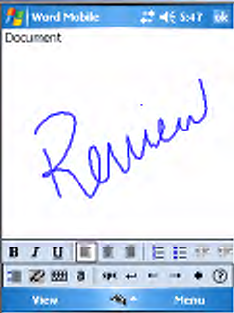
Chapter 2 — Windows Mobile
62 PRELIMINARY - CN3 Mobile Computer User’s Manual
Writing Mode
In writing mode, use your stylus to write directly on the screen. Ruled lines
are displayed as a guide, and the zoom magnification is greater than in typ-
ing mode to allow you to write more easily. For more information on writ-
ing and selecting writing, see “Basic Usage” on page 22.
Written words are converted to graphics (metafiles) when a Pocket Word
document is converted to a Word document on your desktop.
Synchronizing Word Mobile Documents
Word Mobile documents can be synchronized with Word documents on
your desktop. To synchronize files, first select the Files information type for
synchronization in ActiveSync. When you select Files, the My Documents
folder for the CN3 Computer is created on your desktop. Place all files you
want to synchronize with the CN3 Computer in this folder. Password-pro-
tected files cannot be synchronized.
All Word Mobile files stored in My Documents and its subfolders are syn-
chronized with the desktop. ActiveSync converts documents during syn-
chronization.
For more information on synchronization or file conversion, see ActiveSync
Help on the desktop. When you delete a file on either your desktop or your
CN3 Computer, the file is deleted in the other location the next time you
synchronize.
Excel Mobile
You can create and edit workbooks and templates in Excel Mobile as you
do in Microsoft Excel on your desktop. Excel Mobile workbooks are usu-
ally saved as .PXL files, but you can also save them in .XLS format.
When you close a workbook, it is automatically named and placed in the
Excel Mobile workbook list.
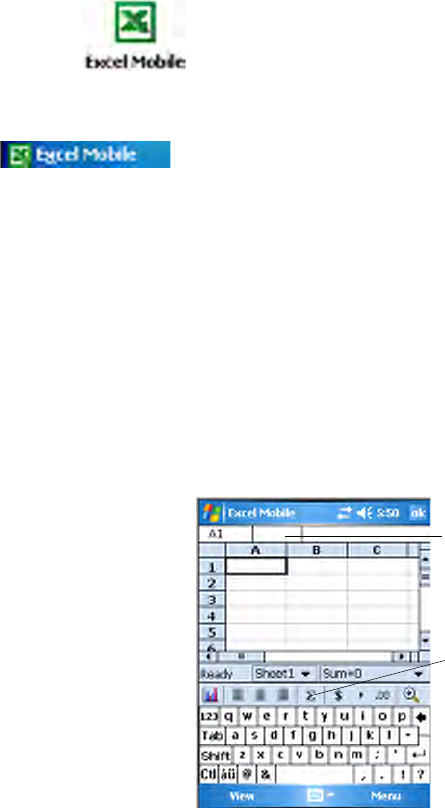
Chapter 2 — Windows Mobile
CN3 Mobile Computer User’s Manual - PRELIMINARY 63
Creating a Workbook
You can open only one workbook at a time; when you open a second work-
book, save the first. You can save a workbook you create or edit in a variety
of formats, including Pocket Excel (.PXL) and Excel (.XLS). You can also
save a workbook as a template by moving the workbook to the Templates
folder.
Excel Mobile contains a list of the files stored on your CN3 Computer. Tap
a file in the list to open it. To delete, make copies of, send files, tap and
hold a file in the list, then select the appropriate action from the menu.
Excel Mobile provides fundamental spreadsheet tools, such as formulas,
functions, sorting, and filtering. Tap View > Toolbar to see the toolbar.
Tips for Working in Excel Mobile
Note the following when working in large worksheets in Excel Mobile:
• View in full-screen mode to see as much of your worksheet as possible.
Tap View > Full Screen. To exit full-screen mode, tap View > Full
Screen.
•Tap View > Zoom and select a percentage so that you can easily read the
worksheet.
• Show and hide window elements. Tap View > Show, then tap the ele-
ments you want to show or hide.
• Freeze panes on a worksheet. First select the cell where to freeze panes.
Tap View > Freeze Panes. You might want to freeze the top and leftmost
panes in a worksheet to keep row and column labels visible as you scroll
through a sheet. Tap View > Unfreeze Panes to undo this process.
Use Excel Mobile to create workbooks, such as expense reports and mileage
logs. To create a new file, tap Start > Programs > the Excel Mobile icon >
New to access a blank workbook. Or, if you have selected a template for
new workbooks under the Menu > To o l s > Options, that template appears
with appropriate text and formatting already provided.
For future use, this is added to your Start menu in the Recent Programs
area, via Start > Excel Mobile.
Cell contents appear here as you enter them
Autosum icon
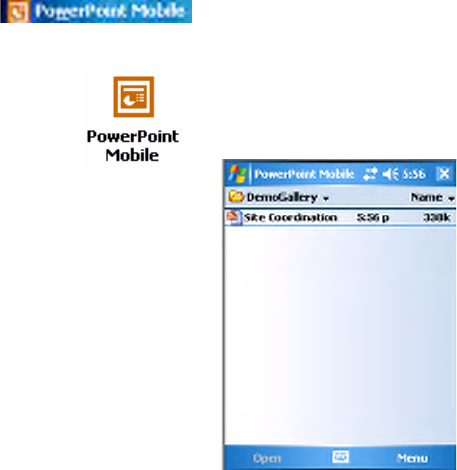
Chapter 2 — Windows Mobile
64 PRELIMINARY - CN3 Mobile Computer User’s Manual
• Split panes to view different areas of a large worksheet. Tap View > Split.
Then drag the split bar to where you want it. To remove the split, tap
View > Remove Split.
For more information on using Excel Mobile, tap Start > Help, then select
a topic.
PowerPoint Mobile
With PowerPoint Mobile on your CN3 Computer, you can open and view
slide show presentations created on your PC. Whether the presentation is
opened from an e-mail message, downloaded from a file share or the Inter-
net, copied to the CN3 Computer via a storage card, or obtained by syn-
chronizing with your PC, slide shows created in *.PPT and *.PPS format
with PowerPoint 97 and later can be viewed on your CN3 Computer.
Many presentation elements built into the slide shows such as slide transi-
tions and animations will play back on the device. If the presentation is set
up as a timed slide show, one slide will advance to the next automatically.
Links to URLs are also supported.
For more information on PowerPoint Mobile while you are in this applica-
tion, tap Start > Help, then select a topic.
To Start a Slide Show Presentation
3Tap the current slide to advance to the next slide. If the presentation is
set up as a timed slide show, slides will advance automatically.
For future use, this is added to your Start menu in the Recent Programs
area, via Start > PowerPoint Mobile.
1To start a slide show presentation, tap Start > Programs > the Power-
Point Mobile icon.
2In the presentation list, tap the slide show you want to view.
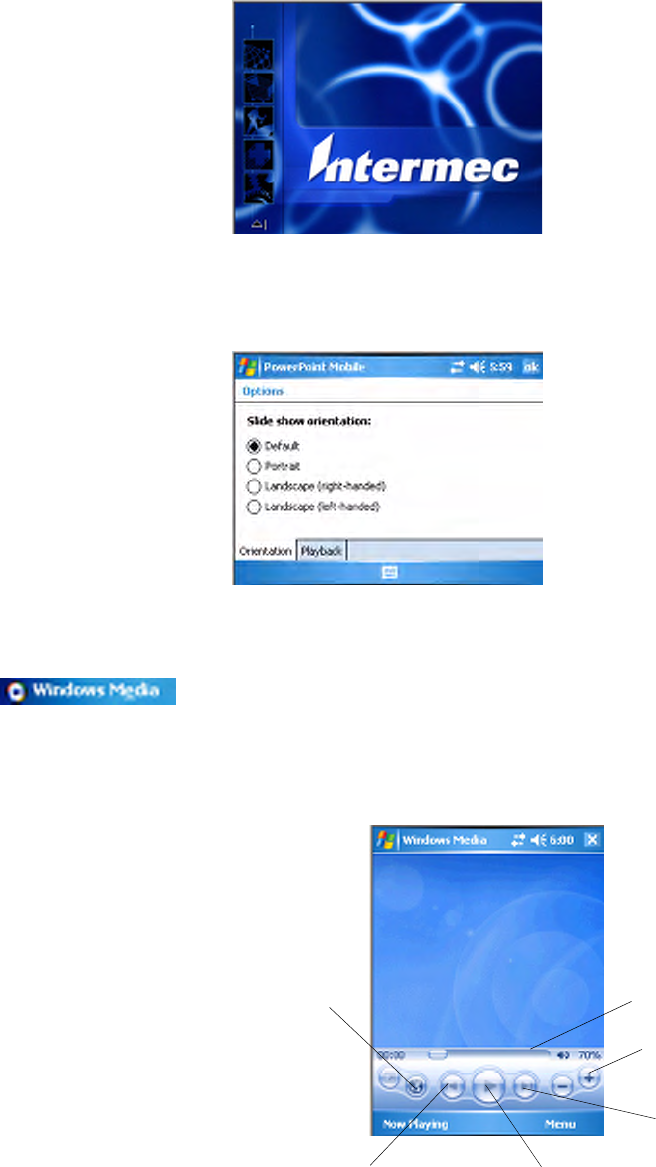
Chapter 2 — Windows Mobile
CN3 Mobile Computer User’s Manual - PRELIMINARY 65
4To view a PowerPoint Mobile presentation in portrait, or right-handed
or left-handed landscape orientations, tap the slide icon (in the bottom,
left corner of the following illustration) for a pop-up menu.
5Tap Show Options > the Orientation tab, then select an orientation.
6Tap Default to view the presentation in the orientation that best fits the
size and shape of the screen.
Windows Media Player for Windows Mobile
Use Microsoft Windows Media Player on your desktop to copy digital
audio and video files to your CN3 Computer. You can play Windows
Media and MP3 files on your Windows Mobile.
Tap Start > Windows Media. For more information about using Win-
dows Media, tap Start > Help, then select a topic.
Indicates the current track progress
Tap to adjust the volume
Tap to skip to the next song
Tap to play the previous song Tap to play or pause
Tap to download
from the internet

Chapter 2 — Windows Mobile
66 PRELIMINARY - CN3 Mobile Computer User’s Manual
Internet Explorer Mobile
Use Internet Explorer Mobile to view Web or WAP pages in these ways:
• During synchronization with your desktop, download your favorite links
and mobile favorites that are stored in the Mobile Favorites subfolder in
Internet Explorer on the desktop.
• Connect to an ISP or network and browse the Web. To do this, create
the connection first, as described in “Remote Access (Modems)” on
page 118.
When connected to an ISP or network, you can also download files and
programs from the Internet or intranet.
Mobile Favorites
Only items stored in the Mobile Favorites subfolder in the Favorites folder
in Internet Explorer on your desktop are synchronized with your CN3
Computer. This folder was created automatically when you installed
ActiveSync.
Favorite Links
During synchronization, the list of favorite links in the Mobile Favorites
folder on your desktop is synchronized with Internet Explorer Mobile on
your CN3 Computer. Both computers are updated with changes made to
either list each time you synchronize. Unless you mark the favorite link as a
mobile favorite, only the link is downloaded to your CN3 Computer. Con-
nect to your ISP or network to view the content.
1In ActiveSync on your desktop, click To o l s > Options, and select
“Favorites” from the Windows PC list. For more information on using
ActiveSync, see ActiveSync Help on the desktop.
2In Internet Explorer on your desktop, save or move favorite links to the
Mobile Favorites subfolder in the Favorites list via Favorites > Organize
Favorites. For more information on using Internet Explorer, see Internet
Explorer Help on the desktop.
3Connect your CN3 Computer to your desktop. If synchronization does
not start automatically, in ActiveSync on your desktop, click Sync.
Mobile Favorites
If you are using Microsoft Internet Explorer 5.0 or later on your desktop,
you can download mobile favorites to your CN3 Computer. Synchronizing
mobile favorites downloads Web content to your CN3 Computer so that
you can view pages while you are disconnected from your ISP and desktop.
To switch to Internet Explorer Mobile on your CN3 Computer, tap Start
> Internet Explorer.
Chapter 2 — Windows Mobile
CN3 Mobile Computer User’s Manual - PRELIMINARY 67
Use the Internet Explorer plug-in installed with ActiveSync to create
mobile favorites quickly. To create a mobile favorite:
1In ActiveSync on your desktop, click To o l s > Options, and select
“Favorites” from the Windows PC list. For more information on using
ActiveSync, see ActiveSync Help on the desktop.
2In Internet Explorer 5.0 or greater on your desktop, browse to the page
you want to view offline, then click Too l s > Create Mobile Favorite.
3To change the link name, enter a new name in the Name box.
4In the Update box, select a desired update schedule to keep the page in
the Mobile Favorites folder up to date. You can also update content by
clicking Tools > Synchronize in Internet Explorer.
5To save the link in a subfolder of Mobile Favorites, click Create In and
select the desired subfolder.
6Click OK. Internet Explorer downloads the latest version of the page to
your desktop.
7To download the pages that are linked to the mobile favorite you just
created, in Internet Explorer on the desktop, right-click the mobile
favorite, then click Properties. On the Download tab, specify the num-
ber of links deep you want to download. To conserve CN3 Computer
memory, go only one level deep.
8Connect your CN3 Computer to your desktop. If synchronization
between your CN3 Computer and desktop does not start, in ActiveSync
on your desktop, click Sync.
Mobile favorites take up storage memory on your CN3 Computer. To
minimize the amount of memory used:
• In the settings for the Favorites information, type in ActiveSync options,
turn off pictures and sounds, or stop downloading some mobile favorites
to the CN3 Computer. For more information, see ActiveSync Help.
• Limit the number of downloaded linked pages. In Internet Explorer on
the desktop, right-click the mobile favorite you want to change and then
Properties. In the Download tab, specify “0” or “1” for the number of
linked pages you want to download.
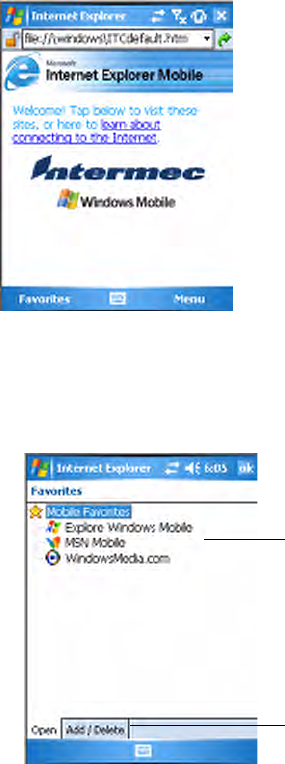
Chapter 2 — Windows Mobile
68 PRELIMINARY - CN3 Mobile Computer User’s Manual
Using Internet Explorer Mobile
You can use Internet Explorer Mobile to browse mobile favorites and chan-
nels that were downloaded to your CN3 Computer without connecting to
the Internet. You can also connect to the Internet through an ISP or a net-
work connection and browse the Web.
Viewing Mobile Favorites and Channels
1Tap Favorites, or Menu > Favorites to display your list of favorites.
2Tap the page you want to view.
3The page that was downloaded the last time you synchronized with your
desktop opens. If the page is not on your CN3 Computer, the favorite is
dimmed. Synchronize with your desktop again to download the page to
your CN3 Computer, or connect to the Internet to view the page.
Browsing the Internet
Set up a connection to your ISP or corporate network using Connections,
as described in “Remote Access (Modems)” on page 118. Tap Favorites,
or Menu > Favorites, and then tap the favorite to view, in the address bar
that appears at the top of the screen; enter the Web address you want to
visit, then tap Enter, and tap the arrow to choose from previously entered
addresses; or while using the CN3 Computer, go to the page you want to
add, tap and hold on the page, and tap Add to Favorites to add favorites.
Tap the favorite you want to view
Tap to add or remove a folder or link